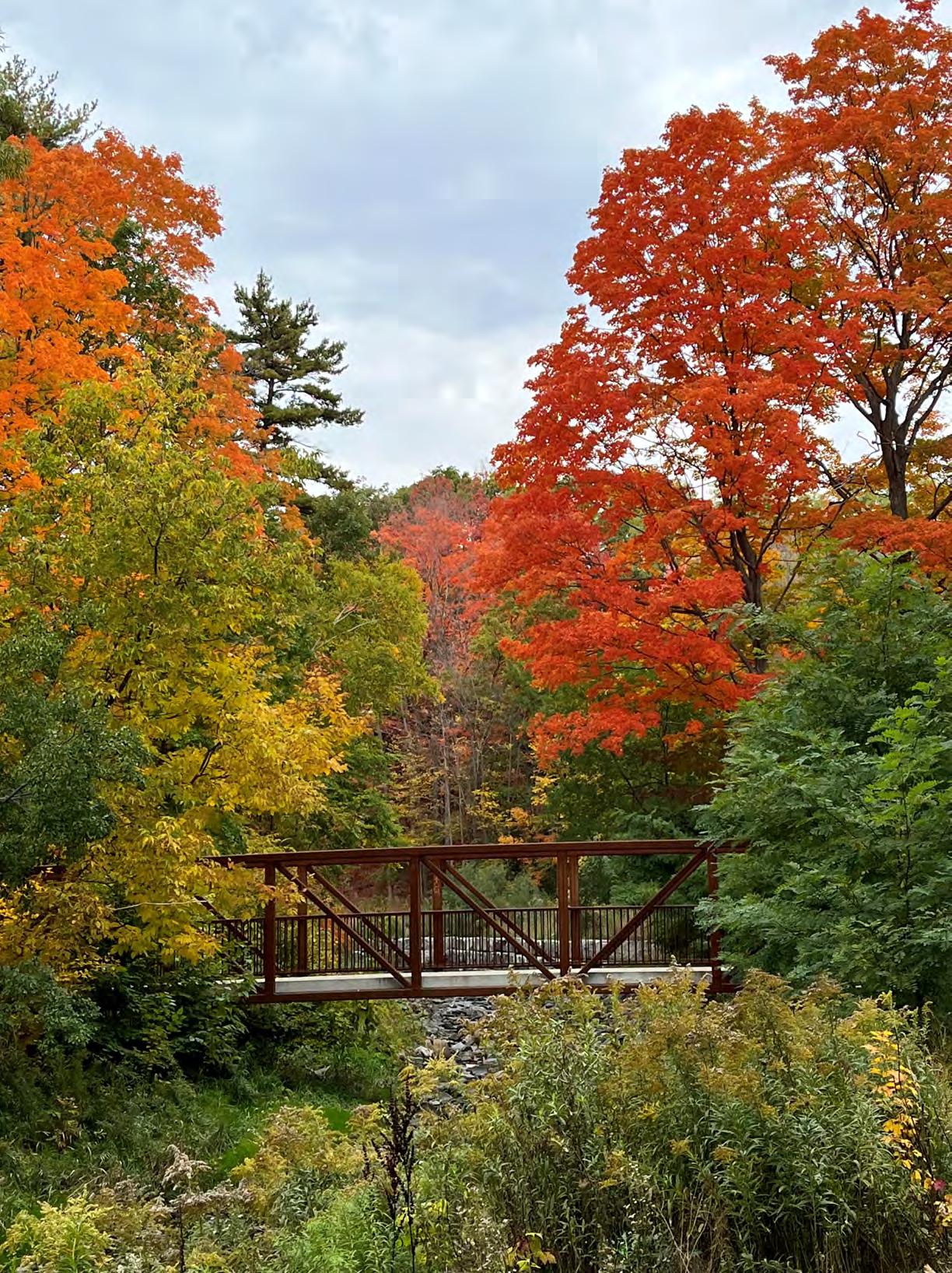

Fall 2023 • Vol 53
OUR RAVINES | NUIT BLANCHE AT TBG
[4] FROM THE GaRdEn together we grow
[6] FaLL adULT PROGRaMS
[7] TBG LECTURE SERIES
[8] OUR RaVInES
What they mean to us and how we can protect them
[10] URBan RaVInE SYMPOSIUM Unravelling the Question of How?
[12] CULTIVaTInG THE FUTURE OF FOOd today’s youth stepping up to the plate
[14] nEW STaFF MEMBERS
JOIn THE TEaM
[16] HISTORY OF GaRdEnInG Plant explorers were responsible for many non-native plants in our gardens
[19] HaRVEST FESTIVaL RETURnS library welcomes nature sommelier Jacob rodenburg
[20] 2024 SnEaK PEEK ball FloraPlant trial gardens in all their blooming glory

[22] InSPIRaTIOnaL
GaRdEn desert botanical garden has 50,000 cacti, trees and flowers
[27] CaCTI and SUCCULEnTS
aS HOUSEPLanTS
[29] TERRaRIUMS any clear glass vessel can become a tiny garden
[30] ORGanIZE YOUR GaRdEn SHEd tips to increase your pleasure and reduce the work
[32] IS THIS a WEEd?
Villainous or good natured – not all are made equal
[34] dOGSCaPInG Keep your pet safe in the garden
[38] BOOK SHELF living Wild. How to plant style your home
[40] VOLUnTEERS ellen Kessler finds community and purpose at the tbg
[41] PUZZLE PIECES
[42] BEWaRE 10 Wacky internet gardening Myths debunked
torontobotanicalgarden.ca 2 Fall 2023
inside Fall 2023 • Vol 53
Fall foliage and flowers in the Garden.
Photo: Sasan Beni
[44] GOOd THInGS
aRE HaPPEnInG nuit blanche, Farmers Market, Music and more
[49] PLanT PROFILE
dark, dramatic foliage takes centre stage
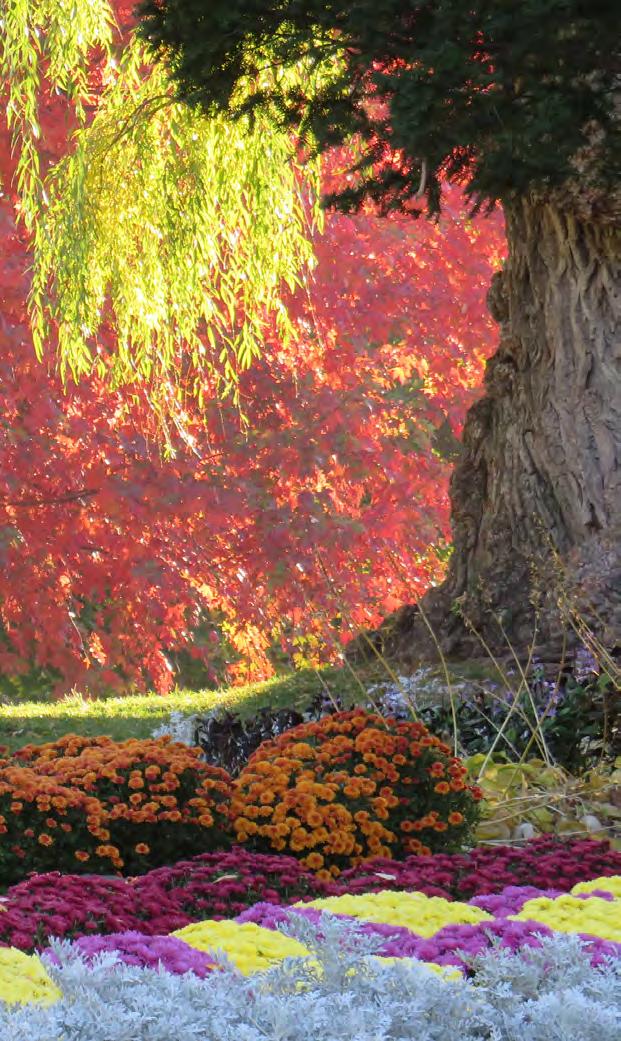
[50] dIY naTURE
WEaVInG Make a piece of art to capture the memory of summer
coVer PHoto: WilKet creeK raVine in aUtUMn.
PHoto: lorraine HUnter

Trellis Wins Gold!
Trellis in prinT in The library
Trellis is once again available in the Weston Family library! The library now has two printed copies of the summer, 2023, edition of Trellis. Come in and visit us to read a copy in the library. Members can check out our second copy! printed copies of Fall 2023 will be available soon.
Trellis maGazine recently received the 2023 Media Awards Silver and Gold Laurel Medals of Achievement for Publisher/Producer: Magazine (Consumer Trade) presented by GardenComm Communicators International.

This international award recognizes individuals and companies who achieve the highest levels of talent and professionalism in garden communications. The 2023 competition had 121 entries in 39 categories.
Trellis received the awards for the Winter 2022-23 issue.
The GardenComm Media Awards showcases writers, photographers, editors, videographers, social media managers, publishers and trade companies that have demonstrated excellence in garden communications in print or electronic communications.
GardenComm, Garden Communicators International, is an organization of professional communicators in the green and garden industry.

torontobotanicalgarden.ca 3 Fall 2023 New Polli N ator Garde N | Holiday d ri N ks | For t H e Birds Winter 22/23 • Vol 51 3 G reat G arde Ns to visit
from the Garden
the world debut of Nîpîy’s Songwalks, a major work about Indigenous water sovereignty from Cree cellist and composer Cris Derksen, preceded by an immersive outdoor prelude performance. If you missed the May performance click here Nîpîy’s Songwalks, to catch a glimpse and be sure to watch our 2024 calendar, as we look forward to building on our partnership with Amadeus Choir.
Bloom: Dance and Circus, returned in July bringing a new level of wonder. This unique intersection of art and nature transformed the garden with aerial performers. The Garden was the stage, shared by the flowers and dancers. This is where the magic happens.
As A pArent I am always in awe of how the clothes that fit the kids perfectly on the last day of school are now too snug or short as September rolls around. Whether the mind, spirit or body has grown over the summer, autumn is when we can stand back and admire the growth and progress.
As a steadfast supporter of TBG, you may be noticing the growth and changes at the Garden, but not quite able to put your finger on distinctly what has changed. Let’s take a closer look at our recent growth as we linger over the warmth of summer and welcome autumn.
Toronto Botanical Garden was a buzz of activity from the early days of spring straight into September. The noticeable hum of summer camp youth returning for the first time since summer 2019, brought renewed energy. The hiatus of camps for so long means that our campers have grown a lot and we also welcomed new campers to our community. More than 200 campers over nine weeks embraced this engaging learning environment. Day after day the TBG team watched the wonder unfold, as another generation deepened their relationship with nature and understanding that plants are essential to life.
New partnerships abound, while we also work to build on the relationships that continue to have a central role at TBG such as Toronto Master Gardeners. We launched a new partnership with AppleTree Markets bringing local growers and makers to the Garden for weekly farmers markets starting in May. And the summer’s harvest will continue to be showcased every Thursday from 3 to 7 p.m. through October 5. The late spring markets merged with the tradition of gathering at TBG on Thursdays for the Edwards Summer Music Series. The eight-week series brings our community together for music, dancing and some of the most stunning hours in Edwards Gardens. The Amadeus Choir, a brand new partner to TBG, brought
We expanded our reach to new audiences by partnering with Toronto Public Library to host children’s summer story times featuring plant- and nature-based stories at the Weston Family Library. We also cross-pollinated with the Bata Shoe Museum’s exhibition providing botanical expertise and programming for their In Bloom Flowers & Footwear Exhibition, on through October 6, 2024.
There are more great things to come as we shift into the cooler autumn days. TBG will join the great Toronto tradition of Nuit Blanche, an all-night celebration of contemporary art, September 23 from 7 p.m. to 7 a.m. Thanks to partnerships with local visual artists Grace Grothaus and Radha Chaddah, you will be able to see TBG through a new lens, deepening your appreciation for the trees in our landscape. Autumn is also when the Ball FloraPlant Trial Gardens put on their final act for the season. Be sure to read which selections were fan favourites this year and what to grow in your garden in 2024 on page 20.
Through all seasons TBG continues to thrive as a hub of learning with inspiring programs. Check out the list of upcoming programs on page 6. Be sure to save the date for the return of the Ravine Symposium on Friday, November 3, where together we lean into the question of how we can support our ravine’s health and our community’s connection to the ravine.
These partnerships are not fleeting moments but rather building blocks to meet our community, diversify TBGs offerings and create strong networks. Together we grow— gaining new perspectives, inspiration and connections.
Continue to lean in and be a part of the growth!
All the best,
Stephanie Jutila Executive Director
CAMP NOTE: Devin, one of our Summer Nature Educators, recalls how he was a TBG Summer camper in his youth, and now had the rewarding experience to return as a summer employee, sharing his passion for the important work of inviting our youngest community members to explore nature.

torontobotanicalgarden.ca 4 Fall 2023
a
Photo:
rthur Mola
TogeTher we grow, gaining new perspecTives, inspiraTion and connecTions
FREE NUIT BLANCHE SEPT 23 7PM-7AM Plan your night toronto.ca/nbto
Fall adult Programs
For more details and updates on fall adult programs visit torontobotanicalgarden.ca. Prices listed do not include applicable taxes and fees.
Bulbs, Corms, Rhizomes and Tubers, Joanna Blanchard, Toronto Master Gardeners (TMG) Learn about geophytes, plants with underground storage, like crocus and daffodils.
Tuesday, Sept. 12, 6 to 7 p.m. Free
Lino Reduction Printmaking, Alan Li
Advanced techniques in relief print making. Create a small selection of prints. Materials included.
Saturdays, Sept. 16 to 30, 1 to 3 p.m.
Public $150; Members $135
Birch Glass Plate—Painted Glass Workshop, Millean Kung Participants will create a glass plate with a painted birch bark design. Beginner level.
Sunday, Sept 17, 10 a.m. to 12:30 p.m.
Public $125; Members $115
Rain Gardens 101 Workshop, Toronto and Region Conservation Authority (TRCA) (Online)
Be inspired by beautiful rain gardens while learning how to create the right rain garden for your property.
Tuesday, Sept. 19, 6 to 8 p.m.
Public $20; Members $15
Soil Matters
Helen Battersby (TMG)
Learn all about soil: what it’s made of and how to make it better.
Tuesday, Sept. 19, 6 to 7 p.m Free.
Early Autumn
3-D Fitness
Workout, Tena van Andel
This 3-D mat class combines thoughtful movement, stretches and weight training.
Tuesdays, Sept. 26 to Oct. 17, 11:30 a.m. to 12:30 p.m.
Public $60; Members $48
Putting Your Garden to Bed, Cathy Kozma (TMG)
Learn how to prepare your garden for winter and spring.
Tuesday, Sept. 26, 6 to 7 p.m. Free
Dawn Birding in Wilket Creek Ravine, Sasan Beni
Join us for a beautiful chorus of birdsong at the start of the day during peak southward migration.

Sunday, Oct. 1, 7 to 8:30 a.m.
Public $12; Members $10
Forest Bathing Ravine Walk, Emma Rooney
A unique forest bathing experience connecting with water and Wilket Creek Ravine.
Sunday, Oct. 1, 10 a.m. to 1 p.m.
Public $50; Member $40
Succulent Pumpkin Workshop, Molly Shannon
Hands-on design of a large ceramic pumpkin planter with a variety of succulent plants.
torontobotanicalgarden.ca 6 Fall 2023
tBg NewslearN
Sunday, Oct. 1, 1 to 3 p.m.
Public $77; Members $70
Floral Design: Sogetsu Ikebana, Margaret Taylor
Japanese flower arranging.
Tuesdays, Oct. 3 to 24, 6 to 9 p.m.
Public $215; Members $170
Floral Design: Classic Design
Fundamentals 2, Pat Ware
In this follow up to Classic Design Fundamentals 1, you will enrich your understanding of traditional design.
Wednesdays, Oct. 4 to 25, 6 to 9 p.m.
Public $215; Members $170
Nature Drawing-Intermediate, Alan Li
This course is ideal for students with previous drawing experience who want to push their creativity further.
Saturdays, Oct. 14 to 28, 1 p.m.
Public $140; Members $126
Saving Seeds: From Gathering to Sharing, TRCA
Learn how to save seeds to ensure their next generation thrives.
Saturday, Oct. 14, 2 to 4 p.m.
Public $20; Members $15
Late Autumn Keep Fit
Workout, Tena van Andel
Improve your agility, balance and strength either standing or sitting in a chair.
Tuesdays, Oct. 24 to Nov. 14, 10 to 11 a.m.
Public $60; Members $48
Late Autumn 3-D Fitness
Workout, Tena van Andel
This 3-D mat class combines thoughtful movement, stretches and weight training.
Tuesdays, Oct. 24 to Nov. 14, 11:30 a.m. to 12:30 p.m.
Public $60; Members $48
Floral Design, Special Occasion
Flowers, Margaret Taylor
Create floral designs for special occasions. Pre-requisite: Classic
Design Fundamentals I & II
Wednesdays, Nov. 1, 8, 15 and 22 6 to 9 p.m.
Public $215; Members $170
Skull Drawing, Alan Li
Explore the intricacies and details of mammalian skulls in this nature drawing class.
Sunday, Oct. 29, 1 to 4 p.m.
Public $75; Members $65
Skulls: the weird and the wonderful, Chloe Kirkland
Discover the magic of skulls and practical tips on skull collecting.
Sunday, Oct. 29, 3:15 to 4:15 p.m.
Public $75; Members $65
Fall Leaf Linocut, Alan Li Create original Linocut prints using native tree leaves. Take home prints.
Saturday, Nov. 4, 1 to 4 p.m.
Public $75; Members $65
Understanding Urban Rivers, TRCA (Online)
Join us with TRCA to learn about challenges facing the GTA's water and how to help! Part of TBG's Urban Ravine Symposium program.
Thursday, Nov. 2, 6 to 8 p.m. Free
Floral Fused Glass Tea Light Holder Workshop, Millean Kung Create two glass tea light holders from fused glass.

Saturday, Nov. 18, 10 a.m. to 12:30 p.m.
Public $125; Members $115
Re T u R ns in Pe R son
This fall we welcome back the TBG Lecture Series in person! This long-running series highlights experts in gardening, conservation, nature and more! Come early to visit the garden and the shop.
Doors open at 6:30 p.m. Lecture begins at 7 p.m. Members FREE (Bring a Friend for $5); Public $20.
• Toronto’s Water: exploring where it flows from and where it flows to: Mariko Uda Mariko is an ecology-minded writer/illustrator, speaker and consultant with a Ph.D in Civil Engineering from the University of Toronto.
Wednesday, Oct. 4, 7 to 8:30 p.m.
• Botanical Inspiration + Footwear at the TBG, Elizabeth Semmelhack, Director and Senior Curator at the Bata Shoe Museum; Nelson Silva, Sustainable Shoe Designer; Roger Gettig, TBG Director of Horticulture.
Wednesday, Oct. 11, 7-8:30 p.m.
• 30 Years on a Sand Dune, Jeff Mason Mason House Gardens, an independent nursery in Uxbridge since 1998.
Wednesday, Nov 15, 7 to 8:30 p.m.
torontobotanicalgarden.ca 7 Fall 2023
lecture
tBg
series
Ravines our

Learn about the history and importance of these natural havens
By Aruna Panday, TBG Adult and Family Programs Supervisor
What are your earliest ravine memories? M INE ARE OF AFTERNOONS SCRAMBLING UP STEEP SLOPES IN THE ‘ FOREST ’ BEHIND OUR HOUSE , MA k ING UP S TORIES WITH FRIENDS, HOPPING ACROSS STONES AND SOMETIMES SLIPPING INTO THE COOL WATER OF THE STREAM AS WE PLAyED AT SCHOOL. WE LEARNED LITTLE OF THE GEOMORPHOLOGICAL W ONDER T HAT WAS OUR PLAy GROUND STEPS AWAy. T HIS AUTUMN W E WELCOME y OU TO JOIN US , TO LEARN MORE ABOUT THESE UNI q UE LANDSCAPES DURING THE CIT y- WIDE ‘R AVINE DAy S ,’ O CTOBER 1-10 AND AT THE TBG’ S U RBAN R AVINE Sy MPOSIUM T HURSDAy, N OVEMBER 2 ON - LINE AND F RIDAy, N OVEMBER 3 IN P ERSON FROM 9 A . M . TO 5:30 P. M .
Facts a bout the Ravines
• The Etobicoke Creek, Mimico Creek, Humber River, Don River, Highland Creek, and the Rouge River are the waterways that dominate Toronto’s landscape. Their ravines cover 17 per cent or 11,000 hectares of the city. Sixty per cent of ravine space is under public purview and 40 per cent is privately owned, cutting through residential, commercial and industrial neighborhoods.
• In this area we now call 'Toronto' complex indigenous societies practiced hunting, gathering and fishing as well as horticultural activities. The waterways provided perfect, natural travel routes.
• From 1791 to 1795 Elizabeth Simcoe, wife of Upper Canada’s first Lieutenant Governor, John Graves Simcoe, lived near the mouth of the Don River, into which Wilket Creek at the bottom of TBG’s garden, flows. She wrote in her diary that the area
“abounded with rushes, wild ducks and black birds with red wings, the river itself with salmon best eaten in the month of June…wild pigeons sometimes darkened the sky.” She even described a delicious meal of raccoon with mint jelly tasting like lamb.
• In 1987, Toronto Field Naturalists identified 185 plants in the Don Valley; 95 were native, 90 were not. At the same period in the Rouge Valley 663 were identified, 440 of which were native and 223 not.


• In 1977, 73 woody species were native to Toronto. Today 30 are gone. The decline of native species has been rapid. The spread of invasives is widespread, accounting for 40 per cent of tree cover and up to 95 per cent of forest floor surveyed in some areas according to researchers at the University of Toronto’s Faculty of Forestry in their 2018 The Toronto Ravines Study: 1977-2017.
• Dog strangling vine has taken over; brought to Ontario from Eastern Europe as a garden plant in the late 19th century, it is a most prolific invasive flora. Other sorts of ecosystem degradation include altered hydrology, salt damage, air pollution, proliferation of trails, off trail activities, opportunistic fauna and flooding.
• Cultural benefits include recreation, aesthetics, psychological well-being (our Forest Bathing walks and mindfulness practices often have waiting lists) and education.
• Plants absorb and filter pollutants, produce oxygen and sequester carbonslowing climate change, provide stability to steep slopes and minimize corrosion.
• Ravines are wildlife sanctuaries. In 1890 cougars roamed as far afield as Thornhill! Today the ravines harbour many small mammals, amphibians, insects and birds. Toronto is
Photos: s a san Beni toronto B otanica Lgarden.ca 9 Fa LL 20 23
situated in the Atlantic Flyway. This past May TBG had its first Dawn Chorus event, an early morning walk through the gardens and ravine, to celebrate the northward migration of many, many birds. In October we host another early morning wander, ‘Dawn Birding in Wilket Creek Ravine,' to catch a bit of the southward migration.
Past Urban Ravine Symposia have focused on the history, present and future of our ravines, with strong emphasis on ecological health and challenges.
There have been revitalization studies, assessments of conservation efforts, one Indigenous perspectives session and implementation strategy discussions. Researchers have shared private land policy research, stewardship on public and on private lands, updates on the Toronto Ravine Strategy and even a sketching session. 2023’s Urban Ravine Symposium asks the question of How? thinking of issues in themes of belonging, action, and challenges; the science. How can we welcome those who have been excluded? Who controls the space, access, belonging? How
do we foster inclusivity, engagement and scientific inquiry? Many challenges exist but how do all the parts connect? How can we address them in a way that makes sense? How can we think of the ravines as a whole? How can we identify technical environmental challenges? Are all ravine systems facing the same issues? How can we share our strengths to get more done together?
We invite you to join us in person to explore understanding the How? To register see torontobotanicalgarden.ca Urban Ravine Symposium: Unravelling the question of “How”.

UrBAn rAvine SymPoSiUm:
The UrBAn rAvine SymPoSiUm returns to the toronto Botanical garden Friday, november 3 from 9 a.m. to 5:30. p.m. this year’s theme is Unravelling the Question of how? tickets include full lunch and access to all talks and workshops. started in 2016, the symposium brings together committed researchers, passionate volunteers, professionals, advocates and community members to learn and connect over toronto’s incredible ravine network. this year’s speakers include carolynne crawley, Jacqueline L. scott and danijela Puric-Mladenovic.
Carolynne Crawley grew up in Mi’kma’ki territory, aka n ova s cotia. d edicated to social and environmental justice, she was a child and youth worker for more than 20 years.
Passionate about reconnecting people and the land, water and all beings, carolynne leads workshops that support development and strengthening of healthy and reciprocal relationships. she is one of the founders of the new initiative turtle Protectors in collaboration with indigenous elders and community members. carolynne is a certified Forest therapy guide and a Blanket exercise Facilitator, contracted by Kairos canada. a member of the indigenous Land stewardship circle, carolynne is an holistic nutritionist and has worked in food security for
over a decade. she is a story teller and co-producer of the upcoming documentary, Reckoning with the Wendigo.
Jacqueline L. Scott is a Phd candidate at the University of toronto, oise, in the department of social Justice education. she is a fellow at the safina center. she volunteers as a steward and as a hike and bike leader with outdoor clubs. Jacqueline leads Black history Walks in toronto. Black outdoors is a blog about her academic journey and outdoor adventures. Jacqueline’s research is on the perception of the wilderness in the Black imagination, or, how to make the outdoors a more welcoming and inviting space for Black people. she also writes travel and adventure books, from a Black perspective.
Danijela Puric-mladenovic is an assistant professor at the University of toronto's Faculty of Forestry. her research and professional work focus on forests in settled and urban landscapes, aimed at providing real-world solutions and tools that support strategic conservation, restoration and integrated spacial planning of green systems, vegetation and forests in urban, peri-urban and rural/agricultural landscapes and their interfaces.
For more information on the Urban ravine symposium see torontobotanicalgarden.ca.
toronto B otanica Lgarden.ca 10 Fa LL 20 23
Rea D Mo R e at Weston Fa M ily l ib R a R y
Weston Family Library, toronto Botanical garden houses canada’s largest private horticulture collection. Members may check out resources for up to six weeks.
• The Toronto Ravines Study Faculty of Forestry, University of toronto, 2018.
• Ravine Re-Create: Design Ideas for Toronto’s Ravines, alissa north, University of toronto, 2018.
• Toronto the Green, toronto Field naturalists, 1976.
• Chatsworth Park Avenue, toronto Field naturalists, 1973.
• Toronto’s Ravines and Urban Forests: Their natural heritage and local history. Jason ramsay-Brown, James Lorimer & company Ltd. Publishers, toronto, 2015.
Ravine Days
From october 1 to 10. the tBg invites everyone to enjoy the beautiful, unique spaces of the Wilket creek ravine as part of the city-wide celebration. events scheduled at tBg include:
TBG Lecture Series: toronto’s Water: exploring where it flows from and where it flows to, Mariko Uda.


Wednesday, oct. 4. 7 to 8:30 p.m.
Guided ravine Tours Friday, oct. 6, 2 to 3:30 p.m.; saturday, oct. 7, 10 to 11:30 a.m.
Dawn Birding at Wilket Creek ravine, 7 to 8:30 a.m., sunday, oct. 1

harvest Day Festival, Family friendly celebration of tBg gardens, the ravines and harvest time.
sunday, oct. 1, 10 a.m. to 3 p.m.
Forest Bathing ravine Walk sunday, oct. 1, 10 a.m. to 1 p.m.

Unravelling the Question of how?
Ca Rolynne C R awley
j aC queline l . sC ott
Danijela Pu R i CMla D enovi C
Cultivating the Future oF Food
today’s youth stepping up to the plate
Food is the ultimate connector. it brings us together as we explore new places and learn about new people. it turns out, food is also a key factor in connecting young people with gardening, horticulture and green industries. As concerns about the sustainability, health and accessibility of food continue to mount, today's youth are stepping up to the plate. they are connecting to food by gardening in their schools, advocating for food sustainability in their communities and developing skills that will shape the careers of tomorrow.
increasingly, young people are rediscovering the joy of gardening through an interest in growing their own food. From balcony gardens to urban farms, they are embracing gardening as a way to connect with nature, foster a deeper appreciation for the food they consume and build the sustainable habits they know are crucial for our future.

today's youth are driving a positive change in the food landscape, but they cannot do it alone. toronto Botanical Garden has a long connection to growing food and providing fresh produce to community members through the teaching Garden, established with the support of the Garden Club of toronto in 1998. since then, children and youth have been coming together to plant and care for the garden with produce supporting the North York harvest Food Bank. tBG also supports green career advancement as youth join the organization as volunteers and staff. these teams are able to experience the fun (and occasional frustration) of food gardening firsthand.
tim
Langford, a teacher in the Green industries program at Marc
torontobotanicalgarden.ca 12 Fall 2023
tBg news
learn
natalie harder TBG Director of Learning
tBg teaching garden campers aged 7 to 12.
Garneau Collegiate institute (MGCi), knows the thread of food is crucial in connecting with youth. While the Green industries program can touch on topics from forestry to floral design, he knows the key to students’ hearts is through their stomachs! he has built out the program to include an “adopt a crop” component where students choose a crop to start in their school greenhouse. they learn all about the needs of the crop, care for the seedlings and, ultimately, plant it in their school vegetable garden in the spring.
in addition to providing life and career skills, the Green industries program also addresses another pressing concern for youth – food security. With rising costs of fresh produce, ensuring everyone has equal access makes programs such as this one that much more meaningful. Plans for the garden at MGCi include growing lettuce, kale, chard, leeks yellow beans, carrots, potatoes and herbs for the MGCi’s hospitality and student Nutrition programs – bringing the food grown at the school right back into the community.
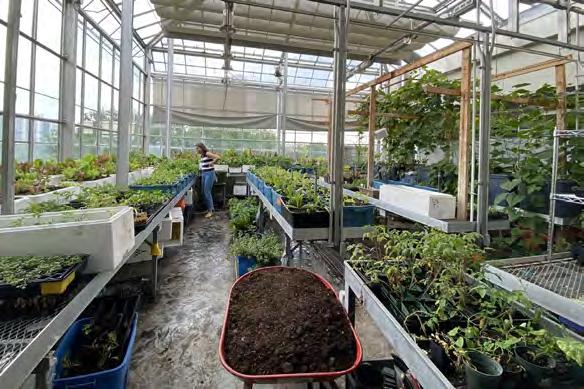
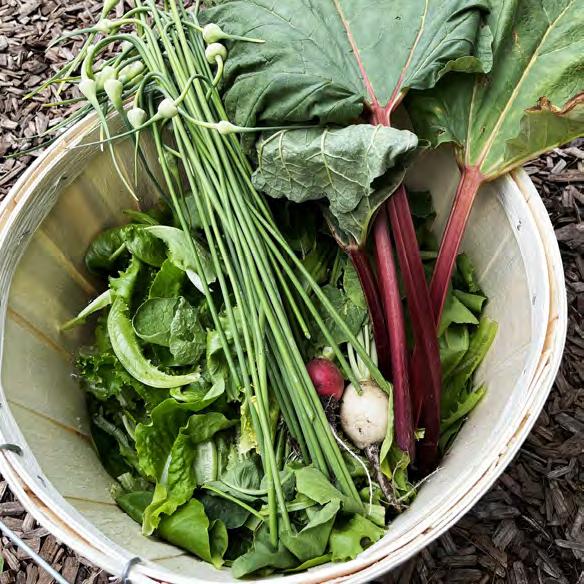

sharon Gunn, an MCGi teacher leading the hospitality and student Nutrition programs, advocates for students having access to fresh local produce. in addition to working closely with the students growing food in their school, her students learn how to grow herbs in their school kitchen. “these students deserve the same quality of fresh produce they serve at Alo Restaurant,” she says. she works with 100 km farms to ensure the food they order is local, high quality and fresh. side effects of this include students wandering into the kitchen to help themselves to some of the fresh produce from the fridge!
Many youth are also taking on active roles as advocates for change by organizing and participating in campaigns that aim to tackle food waste, promote mindful consumption, and advocate for sustainable farming practices. toronto Youth Food Policy Council (tYFPC) collectively believes in a food system that “meets and satisfies the unique food needs of youth”. the incredible team of passionate advocates supports the development of “a sustainable, accessible, affordable, nutritious, appropriate, fairly-traded, and regionally-focused food system.” in addition to making deputations at City hall and through other advocacy work, the council also facilitates Food Policy 101 workshops at schools and community groups and provides a platform for youth to share their academic and creative work in a youth food journal.
today's youth are driving a positive change in the food landscape, but they cannot do it alone. Join the toronto Botanical Garden as we foster a deeper understanding of the food system and promote sustainable practices and sowing the seeds for a more resilient, inclusive and nourishing future. You can make a difference by exploring volunteer opportunities, supporting your local food bank and connecting the youth in your life to food centred programs or job opportunities in your community.
this spring the toronto Botanical garden welcomed gino amboang and lindsay Chisholm to help support learning programs in the teaching garden
Marc garneau Collegiate institute greenhouse.
harvest from the tBg teaching garden.
New Staff MeM berS JoiN the teaM
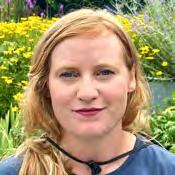







Photos: Geor G e Pimentel (@ G eor G e P imenel) ( l indsay, Gino
HasHem FaraHani
Gino amboanG
Jacqueline ZHanG
rosie aGro
DeboraH Kerr
linDsay cHisHolm
cHloe KirKlanD
leslie HocKley
◗ HasHem FaraHani, tbG’s new bookkeeper, will be supporting tbG’s full cycle bookkeeping tasks, providing timely, accurate and clear financial reporting; supporting our day-to-day business needs, while also helping tbG prepare for growth.
in 2022 hashem moved to Canada from iran, where he completed his bachelors and Masters of accounting at azad University in tehran. while in iran, hashem worked for seven years as an accountant at a printing company. Since arriving in Canada he has worked as an accountant for a local online retailer and at toronto Public Library as a volunteer with the Community Volunteer income tax Program.
◗ rosie agro, the Garden Shop’s new assistant Manager, has an extensive history in managing retail stores as well as a background in cultural studies. having lived and worked around the world, rosie understands the importance of bringing multiple perspectives and diverse ideas into the Garden Shop, and how to create a welcoming environment for everyone who enters.
She plans to support the tbG by upholding our values and beliefs within the Garden Shop by creating a carefully curated store that can not only be a place to grab your garden needs, but also an area for local artists to showcase their work, and small creators to expand their business.
rosie has an honors degree from Nipissing University and holds a qualification in Museums and Cultural Studies from Centennial College. She previously served as a research Lead, preparing an internal report on wayfinding best practices for the Peel art Gallery, Museum and archives.
◗ Jacqueline ZHang, joined the tbG as a Marketing and audience engagement Coordinator in May. She has a broad experience in social media marketing, working with local and international brands back in indonesia.
Jacqueline studied event management at humber College before
working with the toronto Symphony o rchestra as a Patron Services Coordinator. being a part-time barista and social media manager at tbG bloom Cafe made her a frequent tbG visitor. She loves photography, hand lettering and calligraphy, which makes her the go-to person when it comes to handmade signage and cards.
◗ leslie Hockley, our new Led horticulturist, recently moved from Vancouver, b.C. where she was working as a Plant records and Mapping technician for the University of british Columbia’s botanical Garden. She has been in the horticulture industry for almost nine years in a variety of roles from garden and lawn maintenance to nursery production, annual design and tree care.
Leslie studied horticulture at both humber College and the Niagara Parks Commission School of horticulture. her time at the latter is what sparked her interest in botanical gardens and plant records, and led to a summer internship at Denver botanic Gardens in Colorado.
◗ cHloe kirkland is one of the new horticultural team members, joining as a Seasonal horticulturist. She is a recent graduate with honours from the humber College horticultural apprenticeship program. Chloe will contribute to grounds care and plant maintenance.
She collects exotic plants and has a deep love for nature.
◗ d ebora H k err joins the Venue rental team with an extensive background in events, logistics, operations and food service sales. She owned Gourmet Cuisine Catering for 20 years before selling it to Compass Group Canada in 2006.
Deborah’s passion is customer service and building lasting relationships with everyone she meets and with whom she works. her sense of humour and dedication to the team dynamics at tbG is widely appreciated.
◗ gino amboang is the new Nature educator! Prior to tbG, Gino led experiential outdoor- and/or curriculum-linked programs to diverse audiences and age groups with the toronto and region Conservation authority as residential teaching assistant and education interpreter, engaged in hands-on learning with museum visitors at the royal ontario Museum through workshops and school programs as Gallery facilitator, and supported mentorship of equity-seeking students at toronto Metropolitan University (tMU) as Group Mentoring Lead for 2SLGbtQia+ students.
Gino is eager to make a positive impact in the community by creating an inclusive and engaging space to foster confidence and a space for learning. he completed his hbsc. in b iology with a specialization in environmental biology at tMU. as Nature educator, he will work closely with the school, family and children’s education programs throughout the year as well as assisting the maintenance of tbG’s teaching Garden.
◗ lindsay cHisHolm joined the education team in March as a Nature educator. before that she worked at the ontario Science Centre, as a Science Communicator providing informal science learning experiences to families and visiting school groups. as an intern at the Smithsonian Natural history Museum, she created inclusive access to SteM learning through art-based family programming.
Lindsay is also an emerging historian for heritage toronto, writing historic walking tours and has created a digital story on the women’s movement in allan Gardens. She is a recent graduate of the University of toronto, with a Master of Museum Studies and a bachelor of arts in anthropology and Classics, specializing in archaeology.
She has witnessed the positive implications outdoor, hands-on learning can have on children.
torontobotanicalG arden.ca 15 Fall 2023
History of GardeninG
Global plant explorers are responsible for many of the non-native plants found in our gardens today
 By Lee Robbins
By Lee Robbins
Anemone
did you know that many, probably most, of the plants we purchase in our local grocery stores and garden centres are not native to Ontario, much less North America? Today few of us stop to wonder where they originated and how plants such as some anemone varieties, hostas, petunias, geraniums, rhododendrons, clematis, peonies, dogwoods, begonias or our Autumn chrysanthemums came to be here. There are many naturalized non-native plant species growing in our gardens. Plant explorers also introduced invasive species and pests that came along with these shipments that we are still battling with today.
Throughout the 17th to 19th centuries, European countries such as Spain, Portugal, the Netherlands, France and England invested heavily in sea- and landbased explorations as they colonized many parts of the world. These expanding empires discovered exotic plants
that came to fuel a vast international commercial nursery trade. The growing middle classes in these countries, whose prosperity derived from the increasing commerce and industry, viewed the acquisition of rare and exotic plants as a desirable status symbol.
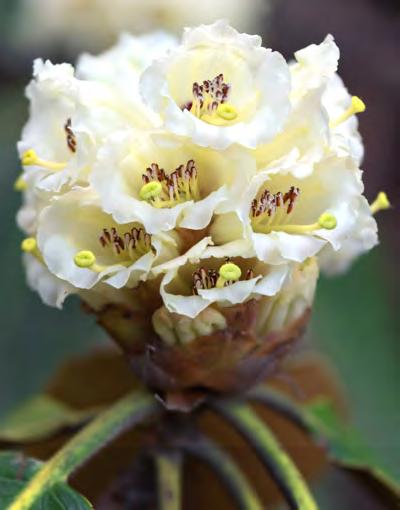
Especially in England, developments in technologies during the Industrial Revolution, such as advancements in glass-making and heating greenhouses, fueled the country’s burgeoning wealth and thirst for exploration and gave birth to the lucrative market for exotic plants. Even a simple technology such as the Wardian case, as was highlighted by Megan Blacquiere in the last issue of Trellis magazine, revolutionized the shipment of plants from around the world, from the 1830s until the 20th century, and proved a boon to the growing nursery and botany industry. Prior to the Wardian case, one in 1,000 live plants survived the journey to England. The Wardian case was made in all

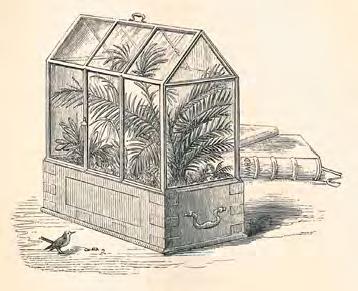
torontobotanicalG arden.ca 17 Fall 2023
“Plant exploers also introduced invasive species and pests that came along with the shipments that we are still battling with today.”
Rhododendron
Wardian Case Kew Wardian Case
sizes and shapes to suit requirements, from shoebox to huge cases in which to transport plants.

Sir Joseph Banks (1743-1820), considered the “father of plant explorers” made significant botanical discoveries of flora on his journeys through South America, Tahiti, New Zealand and in Australia on Captain Cook’s ship Endeavour (1768-1771) and on many subsequent voyages around the world. His travels and scientific patronage enabled him to amass specimens from around the globe.
There were a number of other notable plant hunters active during the Victorian period, and after, such as: Robert Fortune (1812-1880), Sir Joseph Dalton Hooker (18171911) and Ernest Henry Wilson (1876-1930). Hooker is best known for introducing 25 rhododendron varieties from India and the Himalayas to a Western audience.
Next time you have a cup of tea think of Robert Fortune. In order to develop tea plantations in India, the East India Company hired Fortune to steal the secrets of the horticulture and methods the Chinese were using in producing their unrivalled tea.
Fortune used Wardian cases to smuggle 20,000 tea plants from China to India.
So, when next you are wandering around your favourite garden centre, give a thought to the history that brought these plants to our gardens.
tbG promotes sustainable Cultivation
We cannot change history, but we can learn from it to pave the way for a better future. As Toronto Botanical Garden grapples with the realities that the history of colonialism and the injustice to human and plant communities around the globe has wrought, we aim to re-examine our scientific and cultural practices to encourage diverse perspectives and research framed in the context of equality, diversity and inclusion.
From the Library
The following books from the Weston Family Library will give you more in-depth information about the global plant hunters:
1. The Plant Hunters: Two Hundred Years of Adventure and Discovery Around the World by toby Musgrave, chris Gardner, and Will Musgrave QK5. Mus 1998
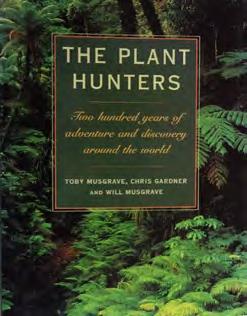
2. Herbarium: The Quest to Preserve & Classify the World’s Plants by barbara M. thiers QK75. thi 2020

3. Flowers from the Royal Gardens of Kew by ruth l a. Stiff QK 98.15. Sti 1988

4. The Wardian Case: How a Simple Box Moved Plants and Changed the World by luke Keogh Sb417. Keo 2020


Photo: xxxxx xxxxxxx
1 2 3
4
GLobaL non native pLants hotspots
Chrysanthemums
HARvesT FesTivAL ReTuRns
library to feature nature sommelier Jacob rodenburg
By Robin Rakowsky Manager, Library Services, TBG
sensory abilities – senses that enable us to connect to the world around us in a deep and abiding way. And, in a way that technology simply cannot replicate,” says Jacob. This book engages all of the senses for deep and nourishing nature experiences. It is a powerful learning tool kit and a cure for sensory anesthesia brought on by screen time, or lives lived mainly indoors.
When I think of fall or autumn, certain words come to mind: harvest, nature, learning, colour and connection. In Ontario, fall is a time when nature changes to its warmest hues of yellow, orange and red. It is also when school-aged children, and many others, return to learning from summer break. But most of all, it is an amazing time to explore the senses of smell, touch, taste, sight and sound.
Toronto Botanical Garden welcomes fall with a Harvest Day
• A LisTeninG GAme • He R e is A n activity to try with family, friends or classmates. To focus your hearing, find a green space nearby – even a few trees and a swath of lawn will work. Ask everyone to cup their hands, squeeze their fingers together

Festival on Sunday, October 1. Join us from 10 a.m. to 3 p.m. for a variety of fun-filled activities. Pick vegetables from our garden for the food bank, meet our worms, plant garlic and join us for a massive scavenger hunt across the garden! Nature sommelier Jacob Rodenburg, author of The Book of Nature Connection: 70 Sensory Activities for All Ages will be in the Weston Family Library at 10 a.m. for a family friendly discussion.
“With all our time spent in front of screens, we tend to forget that nature has graced us with incredible
and slip them behind their ears. n ow push your own ears forward. You’ve turned your ears into deer ears. n otice how much better you can hear?
Ask everyone to close their eyes. every time there is a natural noise or sound, have them lift one finger.
Jacob is the Executive Director of Camp Kawartha and the Kawartha Outdoor Education Centre, a summer camp and outdoor environmental education centre. He is an award-winning educator, qualified teacher with a Master’s in Education, and has taught in the field of camping and outdoor education for more than 35 years. Jacob teaches environmental education at Trent University and has published many articles on education, nature and the value of outdoor learning. He recently co-authored the award-winning The Big Book of Nature Activities with naturalist Drew Monkman.
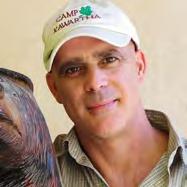
Fall is the perfect time to reconnect with nature and become a nature sommelier. Come and be dazzled by nature’s kaleidoscope of colours, savour the scented world and taste the freshness of the season!
Perhaps they are hearing the whoosh of wind as it strums through the boughs of a nearby pine, the cheerful whistle of a robin in spring or the squeak of snow underfoot in the winter?
Open your eyes and see how many sounds everyone noticed.
torontobotanicalG arden.ca 19 Fall 2023
“With all our time spent in front of screens, we tend to forget that nature has graced us with incredible sensory abilities – senses that enable us to connect to the world around us in a deep and abiding way.”
Jacob rodenburg
 Photos: Ball h orticultural
Coleus Solar Flare
Photos: Ball h orticultural
Coleus Solar Flare
2024 Sne A k Peek
Ball FloraPlant trial gardens
spectacular in all their Blooming glory!
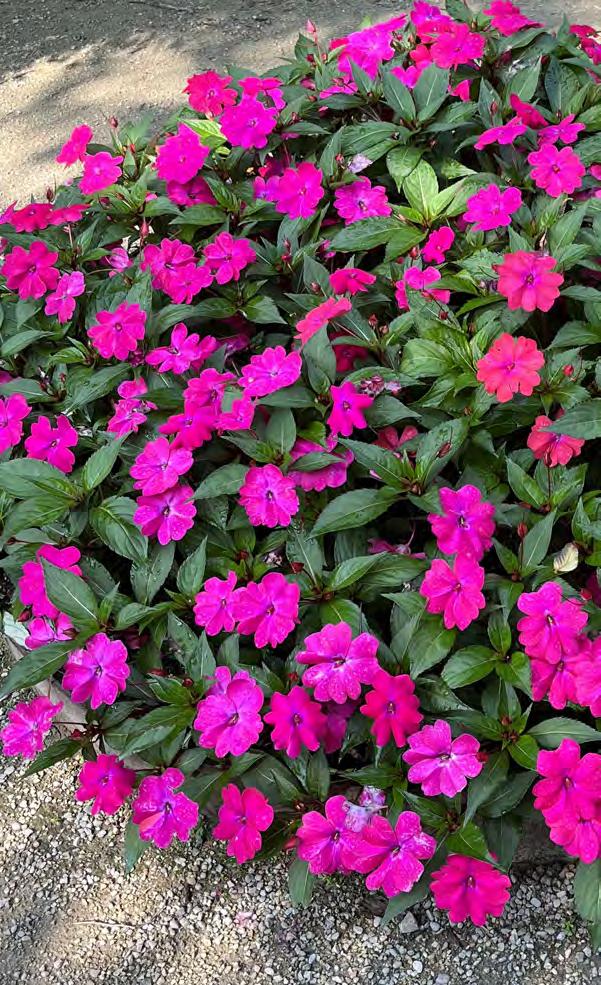 By Leanne Burkholder
By Leanne Burkholder
Newly plaNted Ball FloraPlant and Selecta One trial gardens began displaying their bright colours at the TBG in early July. By mid-August they were at their peak, resplendent in all their blooming glory. And, by early September they were still looking spectacular.
Pink, red and purple tones were prominent, attracting many visitors including photographers and pollinators to the gardens.

“Despite a late planting start, there was much growth progress by mid-July,” commented Tanya Carvalho, Canada Territory Manager at Ball FloraPlant. “We diversified the hummingbird attractors such as the salvia and watched for more hummingbirds being attracted to different garden locations. The trials are a sneak peek of what will be available for your gardens in 2024.”

toronto B otanicalgarden.ca 21 Fall 2023
Impatiens SolarScape Magenta Bliss
Dahlia Venti Royal Purple
Petunias Sure Shot Pink
desert botanical garden has close to 50,000 cactus, trees and flowers from around the world
 By Veronica Sliva
By Veronica Sliva
torontobotanicalgarden.ca 22 Fall 2023
[Inspirational Gardens]
e don’t usually think of cactus as trees, but what about a plant that grows up to 15 metres (50 feet), weighs several tons and can live for up to 200 years? The giant saguaro, the largest cactus in the United States grows only in a “forest” near Tucson, Arizona, in a small area protected by the Saguaro National Park in the Sonoran Desert. You might think that not much goes on in this seemingly hostile environment, but these plants provide homes for birds such as Gila woodpeckers who carve out nests in the trunks of the saguaro, and when the woodpeckers abandon their holes, cactus wrens, elf owls, screech owls, purple martins and house finches take up residence. About 50 types of tree-form cacti are found in the desert.
I saw cacti growing wild on my first visit to Arizona years ago. I wasn’t a big fan of this group of plants but driving through this saguaro forest whetted my appetite to learn more. Since then I have been to Arizona many times, firstly to escape our winter weather, but secondly to learn more about the cacti and desert plants. I am never disappointed. There is much to learn and you don’t have to trek into a saguaro forest to do it.
Desert Botanical Garden

DeSerTS mAke UP 25 per cent of the earth’s surface. And though the environment seems inhospitable, the desert contains fragile ecosystems of plants and animals that have adapted to thrive under harsh and difficult conditions.


If you want to see and learn about desert plants the Desert Botanical Garden in Phoenix, Arizona is a good place to start. Spread across 57 hectares (140 acres) nestled amid the red rocks of the Papago Buttes, this special place is home to 50,000 species of cacti, trees and flowers from desert regions all around the world.
Five trails organized by different themes guide you as you explore the amazing beauty of the unique plants that
W
torontobotanicalgarden.ca 23 Fall 2023
Gila Woodpecker
Mammilari cactus in the wild
thrive in some of the hottest and driest parts of the world.
An easy walk on the Garden’s main trail, the Desert Discovery Loop, is the place to learn about the ways desert plants have adapted to the environment. On this trail, you can see an array of cacti and succulents as well as historic plant collections.
The Sonoran Desert Nature Loop
TrAIL OFFerS sweeping mountain views and an example of an organ pipe cactus forest. To gain insight into the resilience and survival strategies of Sonoran Desert plants and animals, telescopes are set up so you can have a closer look.

As its name suggests, the Harriet k maxwell Desert Wildflower Loop Trail features brightly coloured blooms that attract pollinators such as bees, butterflies and hummingbirds. Here you can find out how flowers, insects and birds play an essential role in desert ecosystems.
The Center for Desert Living Trail is planted with fragrant herbs and vegetables. Homeowners who live in dry climates can discover tips for creating a water-wise home garden.

If you are interested in learning about how Indigenous people used native plants for food, fibre and shelter, the Plants and People of the Sonoran Desert Loop Trail has five exhibits that depict the habitats and lives of the Sonoran Desert’s native people.
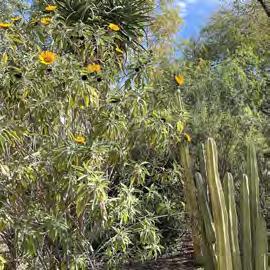
The Butterfly Pavilion
IN SPrINGTIme (march to may) the seasonal butterfly pavilion is open. Visitors can learn about the butterfly’s lifecycle and their role as pollinators, and simply enjoy being among these beautiful creatures. each week, hundreds of new butterflies are released in the pavilion, and new pupae are added to the caterpillar nursery.
xxxxx xxxxxxx torontobotanicalgarden.ca 24 Fall 2023
Photo:
Wildflower Loop Trail
Center for Desert Living Trail

xxxxx xxxxxxx torontobotanicalgarden.ca 25 Fall 2023
Photo:
Desert Discovery Loop
World Class All the Way
AS A WOrLD-CLASS botanical garden, the Desert Botanical Garden has it all, including gorgeous display gardens placed close to the visitor’s centre and are a hub of interest for those looking for design ideas.


Art installations are featured throughout the garden. During my visit, nature-inspired large-scale sculptures by artist rotraut klein-moquay were staged throughout the Garden. k nown around the world, and based in Arizona, r otraut’s artwork explores the energy of the


seasons and the relationship of nature with the sky, sun and universe. Big and bold, her works add colour and drama to the desert landscapes.
Various courses and workshops are offered throughout the year focusing on gardening, landscaping, art, cooking and wellness, as well as special events including concerts and family activities. There is a café and a fabulous, not-to-be-missed gift shop too. For more information see https://dbg.org/.
torontobotanicalgarden.ca 26 Fall 2023
s li V a
Photos: Veronica
Sybil B Harrington Cactus Gallery
Wildflower Loop Trail
Rotraut Klein-Moquay sculpture
People & Plants of the Sonoran display house
In ouR CLIMaTe, we grow desert plants mostly indoors and in containers. they don’t need much water, food, or even ‘good’ soil (though they do crave lots of sunlight), which makes them the perfect houseplant for ‘neglectful’ or beginner plant parents. let’s have a look at five popular cacti and succulents that make good houseplants.
eCHeVeRIaS

in our climate, echeverias with their beautiful rosettes vary in shapes, sizes and colours. no wonder they have become popular as pot plants in summer for sunny balconies and patios. echeverias are not winter hardy but they can be overwintered indoors where they need about six hours of sunlight. Water thoroughly and then let the soil completely dry out before you water again. do not pour water over the leaves. if moisture becomes trapped in the rosette it can cause the plant to rot. the best way is to water from below by standing the pot in a shallow container of water until you see the top of the soil is moist.
aLoe

CRoWn

of THoRnS (Euphorbia milii)
the blooms of this succulent come in deep red, pink, white and yellow. in a desert landscape, it prefers to be planted beneath a tree or large shrub. indoors give it as much light as you can and water moderately from spring to autumn and sparingly in winter.
aloe is a large genus consisting of both dwarf types and tree-like species that grow up to 10 m (30 ft). it is very popular as a houseplant (Aloe barbadensis) and well known as a remedy to treat burns and skin irritations. aloes do best in south or west-facing windows. Water them regularly and deeply, but be sure the soil is completely dry before watering again. this is a fastgrowing succulent and will produce ‘pups’ that can be repotted.

torontobotanicalgarden.ca 27 Fall 2023
Photos: Pixabey, Pexels
Ca C ti and Su CC ulent S a S Hou S eplant S
Cactus Wren on aloe
MaMMILaRIa

Mammilaria is the largest of several genera of small cacti with about 175 species worldwide. all species have spirally arranged wart-like projections (tubercles) with areoles (modified branches, from which flowers grow) and with spines at the ends. these prickly, globe-shaped cacti grow either alone or in clumps. their flowers form a ring around the top of the plant and are followed by tiny fruits that are usually red but can be white, yellow, green or magenta. Place them near the brightest window in your home. From spring to fall water mammillaria deeply, then let the soil dry out before you water again. stop watering in winter when the plant is dormant.
PRICKLy PeaRS (Opuntia)
e asily recognizable, o puntias (prickly pears) are cacti with cylindrical or flattened pads. there are more than 200 species ranging in height from 30 cm (1 ft) high to those that can reach 5.4 m (18 ft). Probably the best one to grow at home is bunny ears (Opuntia microdasys). it has oval pads with tufts of small, golden spines and only grows 30-45 cm (12-18 in) high. grow it in a brightly lit position with four to six hours of direct sun if possible.
Water moderately when plants are in growth (from March/april to september), but more sparingly when dormant in winter, allowing the soil to dry out before watering again.
n oT e: T H e H a RDy P RICKLy Pea R (Opuntia humifusa) is found in southern ontario, growing on the sand spits along the shore of lake erie. it is possible to find them for sale in garden centres, but they are often shared among home gardeners.
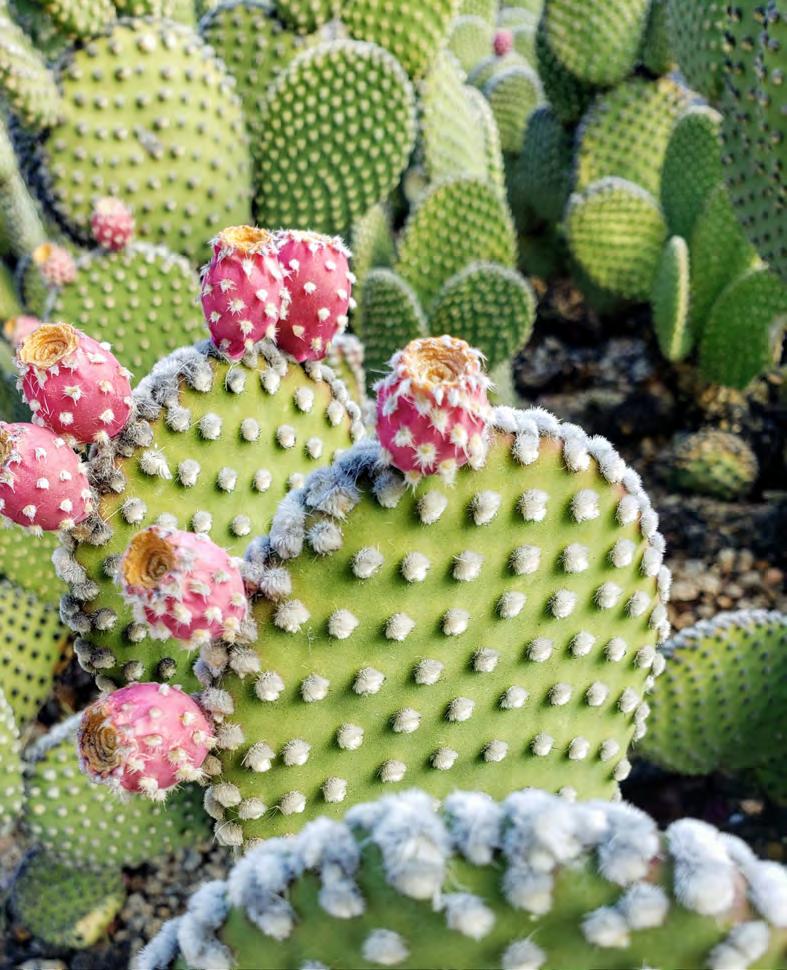
torontobotanicalgarden.ca 28 Fall 2023
as promised in my previous article, I am back to provide you with everything you need to know to build your own terrarium. So, let’s dig right in!
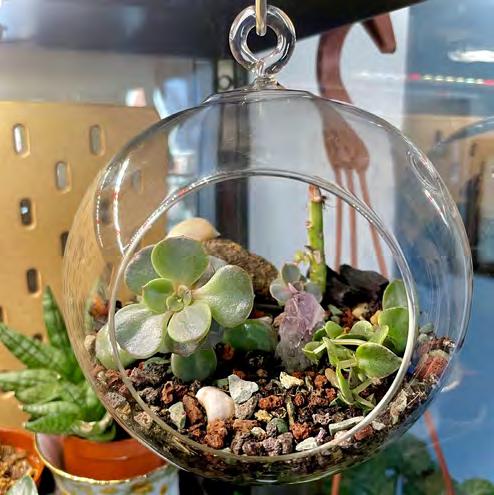
Considerations
The first decision to make is if your glass enclosure is suitable for arid or tropical plants. With arid plants you will want to use something with a large enough opening to allow for ample air flow and little accumulation of humidity. A glass bowl or orb will do nicely. Tropicals require higher humidity and therefore a smaller opening is more suitable. This could include glass vases, cookie jars, or mason jars. Any type of clear glass vessel can be repurposed into a terrarium, as long as the container complements the plant.
The next detail to consider is the types of plants to use. You will want to choose a specimen that is slow growing and will remain relatively small. With arid plants this is easy since most cacti and other succulents are very slow growing. Some tropical examples include: nerve plants, arrowhead vine, ferns, begonia, creeping ficus, peperomia, pilea plants, air plants and moss. Species can be planted whole or as a cutting or division.
The growing medium will be another important component to your mini ecosystem. Bagged potting mix can be purchased from any garden centre or you can create your own mix. I like to use these recipes from Terrarium Tribe (Terrarium Tribe, 2023):
TeR RaRI uMS
any clear glass vessel can be repurposed into a tiny garden
By Megan Blacquiere TBG Seasonal Horticulturist
arid Plants:
2 parts base: coco coir or peat moss
1 part vermiculite
1 part perlite or lava rocks
0.5 parts earthworm castings
0.5 part horticultural charcoal
Tropical plants:
2 parts base: coco coir or peat moss
1 part sphagnum moss
1 part earthworm castings
1 part perlite or lava rocks
0.5 part horticultural charcoal
Decorative items such as rocks, sea glass, shells, moss, driftwood or figurines can add that bit of charm to your little display. This is your chance to get creative and have some fun with it!
Steps Now that you have the components, all you need to do is follow these steps to build your terrarium.
1. Potting Mix: pre-moisten your soil mix and fill the container with enough soil for the roots to grow while leaving enough room in the jar for the foliage.
2. Planting: add in your specimens and water around the base of the plants.
3. Decorating: place your decorative items.
4. Cleaning: clean insides of the glass container with a small brush.
5. Light: find the appropriate spot in your home to place your terrarium, based on the lighting requirements of its plants.
Care Terrariums are low maintenance as long as you provide the right container for the plant and proper lighting conditions. Watering should be less than that of a regular potted plant. When you notice the soil has dried out make sure to add more water. k eep an eye out for mould, as this can be a common issue with terrariums. If you notice any mould forming remove it immediately. Watch your plants grow and enjoy the little world you have created!
I hope you have been inspired to build your own terrarium.
torontobotanicalgarden.ca 29 Fall 2023
Photos: Megan b lacquiere
Tips for increasing your pleasure and reducing the work.
By Georgie Kennedy
Organize Your g arden Shed


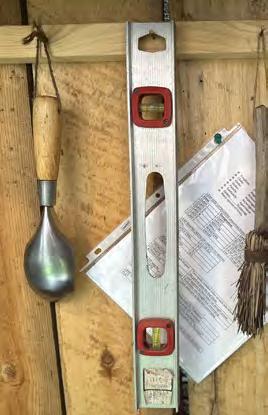
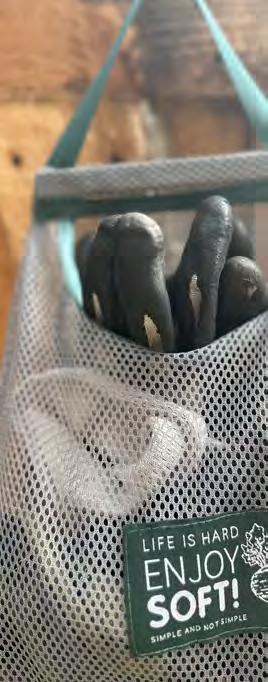

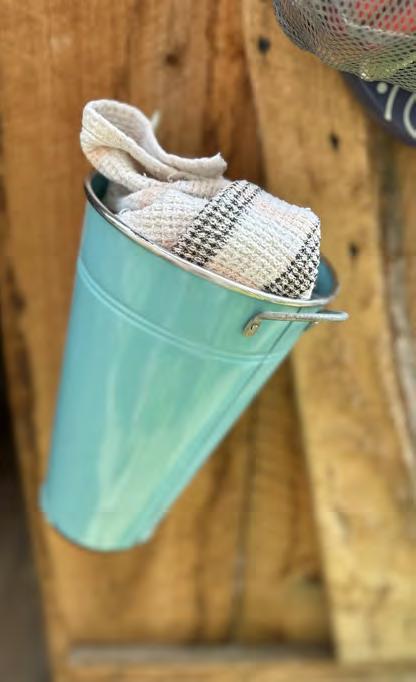 Veggie and herb labels
Selection of secateurs
Bag of gloves
Cleaning rags
Holes drilled and marked for each size of screwdriver.
Yellow dust catcher tucked between a shovel and a spade
Veggie and herb labels
Selection of secateurs
Bag of gloves
Cleaning rags
Holes drilled and marked for each size of screwdriver.
Yellow dust catcher tucked between a shovel and a spade
Most toronto garden sheds sit untouched for five or six months of the year, making them the perfect winter lodgings for rodents, birds and insects. I’m naturally reluctant to enter any space that is dusty, dirty, or covered in mouse detritus. If you’re the same, here’s how to deal with the mess and keep it at bay during the growing season.
Set up a clean, welcoming, functional garden HQ
• Plan for a few hours of autumn and spring cleaning.
• On the appointed day, remove and wipe down everything. Decorative objects, watering cans, trugs and hoses can stay out. Vacuum and sweep away all droppings, cobwebs and saw dust. Yes, my central vac hose reaches out to the shed!
• Place only necessary and workable items back inside.
• Stay organized by having a specific place for everything on a wall or ledge:
1. Keep your most useful items close to the entrance: pruning shears, broom, weed digger, screwdriver set, scissors, twine, supports, Japanese Hori Hori knife, shovel, yard waste (garden treasure) bags, measuring tape, kneeling stool, gloves, cleaning rags.
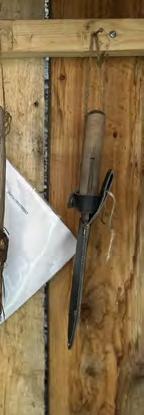
2. Most tools have holes through which you can loop a string. Hang them up with screws, nails and cup hooks.

3. Punch holes in your plant labels and hang them by kind.
4. Screwdrivers fit nicely into holes drilled in 2 x 4 boards.

5. A broom hangs on the back of the door with its own tool holder
6. Foldable dolly and/or wagon stands in the corner.
7. Lesser used items such as fertilizer, tap coverings and long poles can be placed up high.
A potting bench can save your back when preparing annual containers and setting up tomato seedlings. Soon after the shed is cleaned, I bring mine out from the garage. Close at hand:
• a generous supply of potting soil in a bin that can be rolled to any part of the yard;
• water in a long unkinking water hose;
• an old radio for listening to gardening gurus like Paul Zammit on the CBC gardening call in show
shelves are necessary for small sheds. Plant propagators and dividers naturally will collect pots and saucers of all sizes and shapes and need a place to be stored. Tender plants require protection, ideally in shade. Sturdy homemade shelving is easy to make with bricks and leftover boards.
Repeat the process in the fall, being judicious about what goes into the shed over winter.
• Save your back by leaving large ceramic pots and heavy décor outdoors. Turn them over and place a stone or piece of wood under one edge to create a gap that will prevent freezing.
• To remove rust from tools: mix sand and oil in a bucket and put metal parts point down. Leave for a few hours and wipe clean.
• Before I close up, I throw in a few scented dryer sheets and open up some mentholated rub. Apparently, mice do not like the smell.

• Return the clean potting bench to the garage. Varnish once every two years.
Develop a garden work flow
• Start with a tour of your property or allotment. Our season is short and new miracles happen daily.
• Plan out what you’ll accomplish. A little bit every day adds up, especially if you allow the microorganisms to digest fallen leaves and provide rich soil in a healthy ecosystem.
• Open the shed door wide and gather supplies. Going organic can simplify every task.
• Stay in the shade if you can: southwest in the morning and northeast in the afternoon.
• Allow helpers to help. Children are the keenest, kindest, chirpiest and most agile of gardeners.
• Take water and rest breaks.
• Leave ten minutes for tidying up every day: collect all tools, wipe them off, brush soil off the bench, sweep and put it all away.
I have a tiny ritual of closing the shed door once I can see that all tools are inside in their proper places. It’s satisfying to realize I won’t waste time and energy looking for that one item left in the herb garden when I return tomorrow
Toron ToboTanicalgarden.ca 31 Fall 2023
T o s: g
Pho
eorgie Kennedy
Is th I s a Weed?
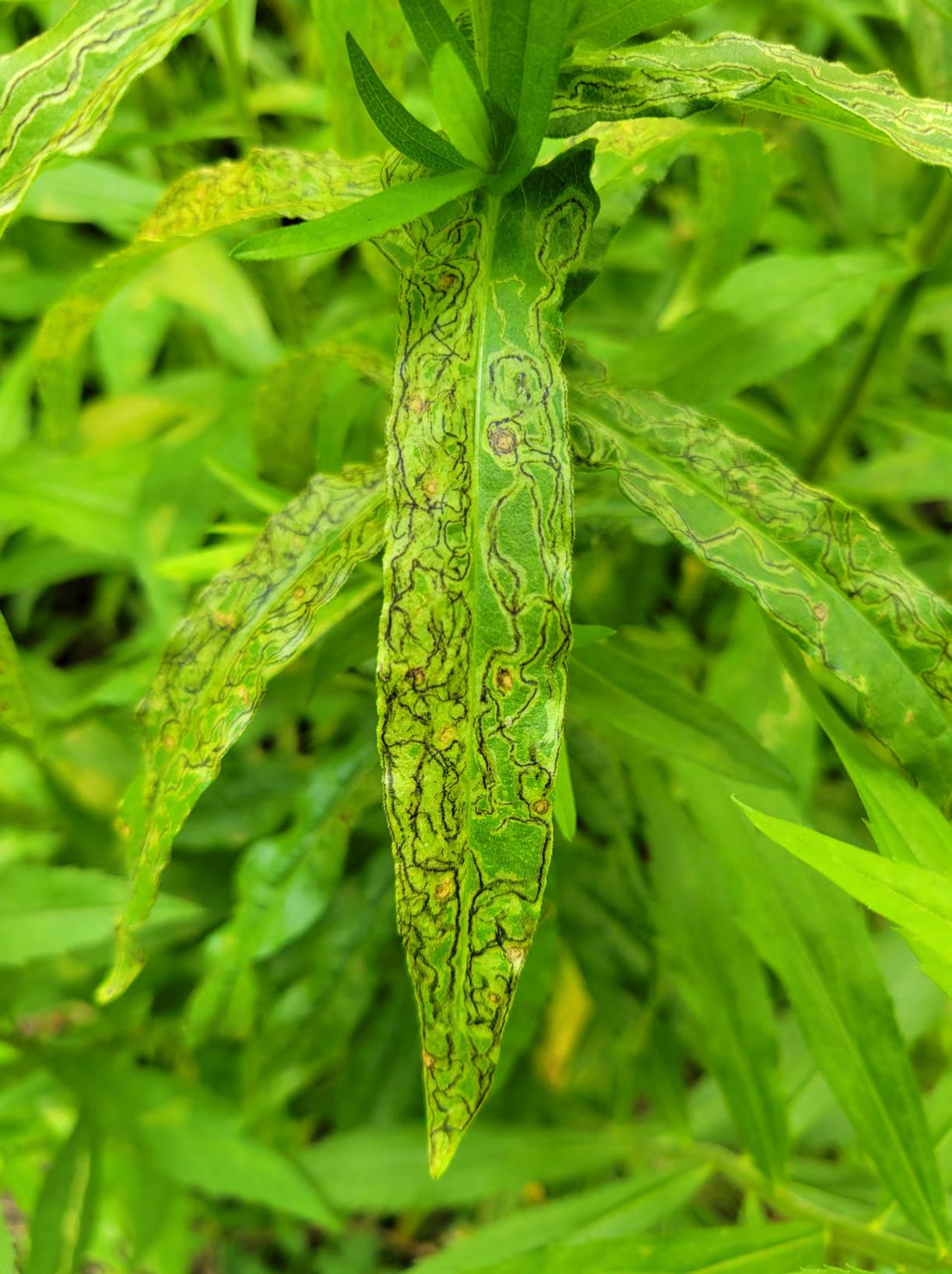 New England aster with tattoos (leaf minor damage)
New England aster with tattoos (leaf minor damage)
Villainous or good natured – not all are made equal
By Sasan Beni Seasonal Horticulturist
My colleagues and I spend a lot of time in the weeds - quite literally - often crouched down on all fours... Someone told me years ago that you can always distinguish a gardener, not by their green thumb, but by their black knees. And while working at TBG with our dedicated teams of volunteers, the most common question asked is always: “Is this a weed? Do I pull it, dig it out, grip-and-rip it?”
Not all weeds were made equal, and I like to think of them as characters in a story, to be more specific when calling them out. There are villainous weeds and good-natured weeds, weeds that are shy and ephemeral and weeds that haven’t got a clue, all of whom are resilient in their own way.
Simply put: any plant in your garden whose trajectory doesn’t align with your own aspirations is a... you guessed it, and for the remainder of this piece I will do my best not to use the W word.
Invasive villains
The villains of this story are the invasive plants, the foreign flora running rampant in our parks and gardens. No matter where you encounter them in our city, they don’t belong there.
Take dog-strangling vine (Cynanchum rossicum) for example. This Eurasian perennial vine is one of Ontario’s most unwanted invasives. Although there are no known reports of dogs being strangled by it, DSV is a master of “choking out” and displacing native plant communities and wildlife, altering forest ecology in the process.
A disturbing observation in recent years has shown monarch butterflies mistaking the evil vine for common milkweed (Asclepias syriaca) and laying their eggs on its glossy, oval-
shaped leaves. Upon hatching, the caterpillars will have nothing to eat and starve to death as a result.
In my experience, you need to dig this plant out, and early detection of its presence in your garden is crucial; a second- or third-year plant will have developed a complex, mop-like system of fibrous roots that is extremely difficult to remove. They break off easily when pulled, ensuring that part of the rootstock remains in the ground and sprouts a new plant. Some gardeners choose to cut the vine at the base when digging isn’t an option, to starve the roots and keep the plant from going to seed. And it goes without saying, DSV roots and seeds should not be composted. Not all invasive flora were made equal, but they all need to be disposed of in garbage bags.
Some invasives plants, like garlic mustard (Alliaria petiolata) are edible. It was originally brought here from Europe for its herbal properties. Since then this villain has become one of the most dominant invasives. As the name implies, all parts of the plant have a strong garlic scent when crushed. And contrary to its perennial counterparts that spread by both seed and rhizome, garlic mustard is a biennial (has a two-year life cycle) that spreads only by seed. It also has a slender taproot that is much easier to remove and requires less under-breathcursing. However, said taproot has another trick up its sleeve; perhaps, the greatest weapon in its arsenal: it releases chemicals that hinder mycorrhizal bacteria in the soil, responsible for root health and the transfer of nutrients to our native plant communities.
So grab a kneeling pad and trowel, we’ll be here a while longer. You can dig it out, cut it, take it home and make a salad. Friends keep sending me recipes for pesto using garlic mustard, and even though I like pesto as much as the next guy, I tell them that the world doesn’t need that much of it.
Unwanted guests
Last year we did a lot of work in the parking lot beds, perhaps, the harshest microclimate here at TBG. Each bank
has its own usual suspects of unwanted guests (still not using the W word) and our work went beyond just removing them. We mulched the entire area. We planted a wide variety of native species renowned for their resiliency and ability to spread: plants like wild strawberry (Fragaria virginiana), harebell (Campanula rotundifolia) and white snakeroot (Ageratina altissima), all of which are extremely drought tolerant plants that can grow in the barest of soils, with an extended bloom period.
Species such as silverweed (Argentina anserina) and Ohio goldenrod (Solidago ohioensis) were also added to the parking lot. The goal is to create a sense of place by introducing plants that are both attractive to pollinators and able enough to compete with the environmental conditions in the parking lot and all the unwanted guests that have made it their home. Less than one year in the ground, the silverweeds have already “stretched their legs,” their stolons are running, trying to take up more room. I’m excited to see the progression.
Just a weed?
A few weeks ago, while working with volunteers in the entry garden, I overheard a couple of them debating the identity of two different plants. It was a brief discussion; they both concluded that the plants were weeds and asked me to confirm. They were right, but I had to give them a hard time. I said: “excuse me - just a weed? The one that’s blooming next to you, sir, is Philadelphia fleabane (Erigeron philadelphicus). It supports a wide variety of native bees and happens to be a favourite nectar source for the northern crescent butterfly. And the plant further behind is New England aster (Symphyotrichum novae-angliae ) which just happens to be a larval host for the same butterfly. Just some weeds? I think not... but yes, let’s weed them out, because there’s no room for them in Piet Oudolf’s meadow.”
Grab your kneeling pad and trowel, we’ll be here a while longer.
torontobotanicalgarden.ca 33 Fall 2023
How to keep your pet safe in the garden
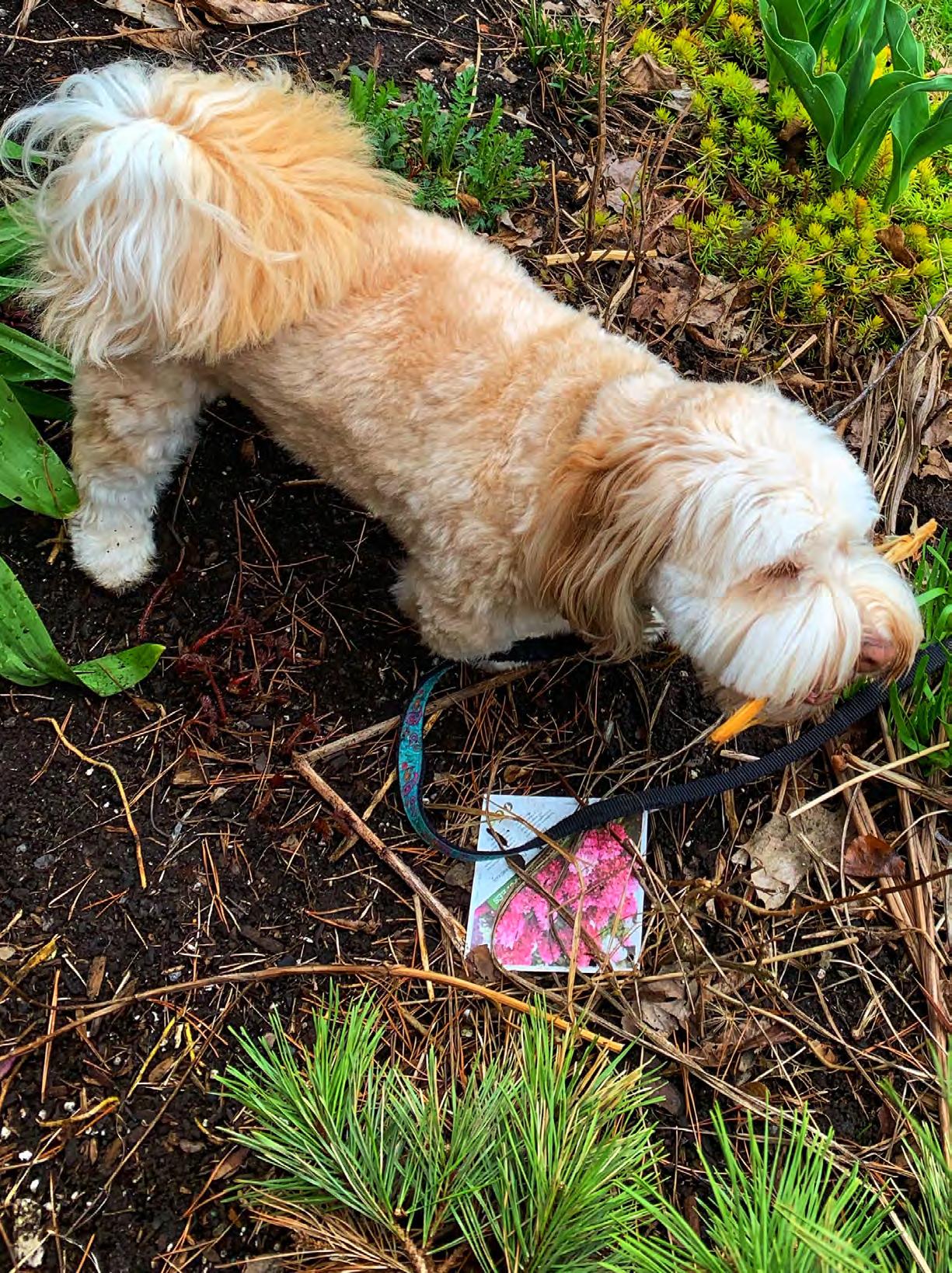 By Carol Gardner
By Carol Gardner
dogscaping
scaping
Dogs anD garDens: two of my favourite things. Unfortunately, when you have both, some caution is advised because many garden plants are toxic to animals and, sometimes, to people. This doesn’t mean that you have to choose between your pet and your favourite plants; it just means that you have to know what’s what in the garden and take some sensible precautions.
Your best bet is to train your dog (cats are not trainable in my experience!) not to go into your garden beds; I’ve found this pretty easy to do, although, when you’re distracted, dogs don’t mind a little sniff and nibble around the garden’s perimeter. So, if you have some toxic plants, place them far away from the border of the garden and keep your dog on a leash when you’re not around the garden with him (or her). As for cats – what can I say? Cats are best kept out of the garden if you have dangerous plants. And even better, kept inside so that they don’t kill birds.
You can, of course, avoid toxic plants altogether if you have the willpower to do so. If your dog or cat does ingest dangerous plants, visit your vet or emergency vet clinic immediately. It helps if you also bring the plant, or a picture of the plant, in order to help the vet assess the toxicity. Symptoms vary with the toxin, so call your local animal poison centre (800-213-6680) if you have concerns. Canada’s Guide to Dogs https://canadasguidetodogs.com has a variety of excellent information.
A few of the most dangerous (and common) garden plants found in Canadian gardens are:

1. autumn CroCus (Crocus speciosus) – contains the toxin colchicine which can cause gastrointestinal bleeding, severe vomiting, kidney and liver damage, and respiratory failure. Symptoms might be delayed for several
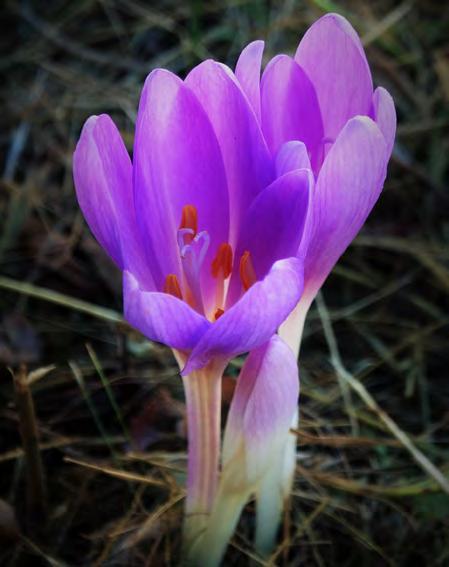
torontobotanicalgarden.ca 35 Fall 2023
Autumn crocus contains the toxin colchicine that can cause gastrointestinal bleeding, vomiting, kidney and liver damage and respiratory failure.
days, so if your dog has ingested any part of this plant, take immediate action.
2. All parts of the DaffoDil (Narcissus) are poisonous, especially the bulbs. So, if you have the bulbs around the house prior to planting (and let’s face it, you always do. I don’t know a single gardener who plants their bulbs as soon as they arrive), ensure that your animals can’t get access and do your fall bulb-planting without animal assistance! Squirrels famously avoid daffodil bulbs, which is why they live to destroy all your tulip bulbs.
3. Delphinium is a species of over 300 plants of the genus Ranunculaceae- that contain diterpene alkaloids that can cause serious neuromuscular effects that can lead to illness, paralysis and death in dogs, cats and humans.
4. foxglove (Digitalis purpurea) is a good news/ bad news plant in that it is used effectively in medical treatment, but, if ingested, the cardiac glycoside that it contains can lead to a swift death.
5. monkshooD or Wolfsbane (genus aconitum) –this beautiful fall-blooming plant contains a deadly poison called aconitine. Recently, 12 people in Markham came down with deadly symptoms after eating aconitine in a restaurant; some had to be rushed into Intensive Care. The toxin was found to have been contained in a jar of contaminated spice used in Asian cuisine. Aconitine is so poisonous that a lethal dose for humans could be the size of a sesame seed. In ancient times, aconitine was used as a poison on spears and arrows. According to legend, Cleopatra took her life by ingesting a mixture of opium, aconitine and hemlock. Whether that is true or not, it sounds like this plant is a good one to avoid.
THe nuts from Black Walnuts can be dangerous as they start to decay and produce mould while on the ground. They can cause digestive upsets and seizures.
Cocoa bean mulch - veterinarians have warned that cacao shells contain the same ingredient that makes chocolate toxic to dogs. Because of the delicious smell, it attracts both cats and dogs. Ingestion can cause severe convulsions and death. Some manufacturers now say that they have removed the dangerous chemical ‘theobromine’ from their mix, but read the label carefully.
At any rate, be careful in your choice of mulch because some of
The American SPCA has a long and depressing list of toxic plants at www.aspca.org/pet-care/animal- poisoncontrol/dogs-plant-list
All this being said, I’ve had five dogs (one happily still with us) and lots of gardens, and all the dogs died at ripe old ages of natural causes. Dogs and cats have good instincts and that, combined with some caution on the gardener’s part, can make for a safe gardening season. As for me, I’m digging out my monkshood before the sun goes down!
OtHer POtentiAl tHreAts
them contain dyes, chemicals and toxic ingredients. The safest mulches are the natural ones – like pine or cedar bark.
Avoid at all costs the dyed mulches (for both esthetic and safety reasons). The dyes in mulch are thought to be safe, however, the source of most dyed mulch is recycled wood. The issue there is that some of that recycled wood may be treated with creosote which is toxic to dogs. There is also a debate about whether dyed mulch is good for the soil, but I know for certain that it isn’t good for the soul – so ugly!
Artificial grass can become hot enough to burn your pet’s paw pads
in extreme heat. Check it out before letting them wander.
In hot weather, pets can very easily get heat stroke. The symptoms are excessive panting, muscle twitching, anxious or dazed look, vomiting, weakness, increased drooling, diarrhea.
Make sure your dog always has access to water, and keep the water bowl in the shade. Do the daily walks early in the morning or in the evening when it’s cooler. For more info check with the Ontario Veterinary Medical Association at https://www.ovma.org/pet-owners/ basic-pet-care/pet-safety-tips/

torontobotanicalgarden.ca 36 Fall 2023 P H otos: c arol g ardner, l orraine Hunter and Pexels.
Carol Gardner and her Havanese dog Bentley.
“ dogs and cats have good instincts and that, combined with some caution on the gardener’s part, can make for a safe gardening season.” Carol Gardner
All parts of the daffodil are poisonous, especially the bulbs.


Monkshood contains a deadly poison.
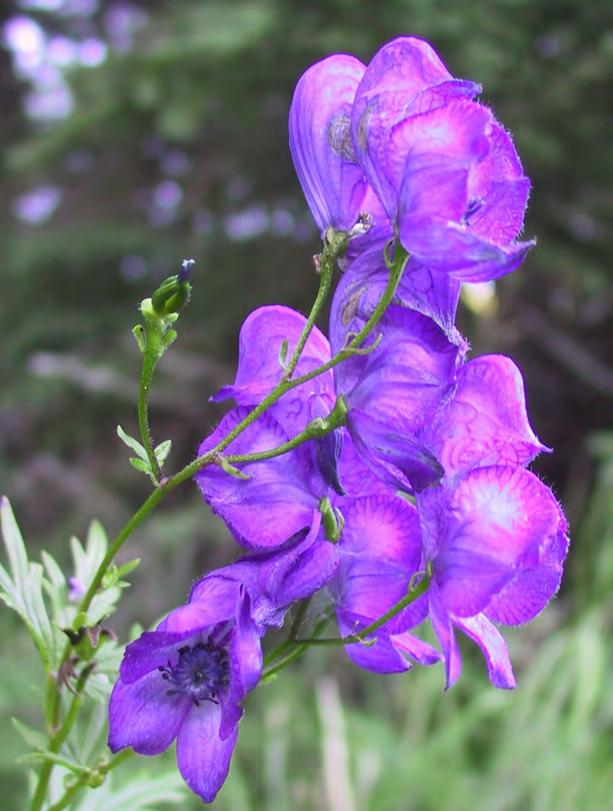
Foxglove, if ingested, can lead to a swift death.

Delphiniums contain diterpene alkaloids that can have serious effects.

Book Shelf
Living Wild How to Plant Style Your Home & cultivate Happiness
Reviewed by Veronica Sliva
Not your typical book on houseplant care, in Living Wild, Hilton Carter uses plants in the same way interior designers use elements such as furniture and wall coverings. In the book, plants are not just decorative elements in a room, they are the main event.
With sumptuous images, Carter shows us how to create gorgeous spaces filled with plants used in inspiring ways. He covers interior design topics such as colour schemes, and textures and tells us how to use supporting materials to showcase all that greenery. He then tackles styling plants with ideas such as choosing the perfect planter and using “statement” plants as living art.
We often hear the phrase “bringing the outdoors inside”. In Living Wild the chapter called Outdoor Glamour turns that notion around by covering how houseplants can find a happy and stylish home outside.
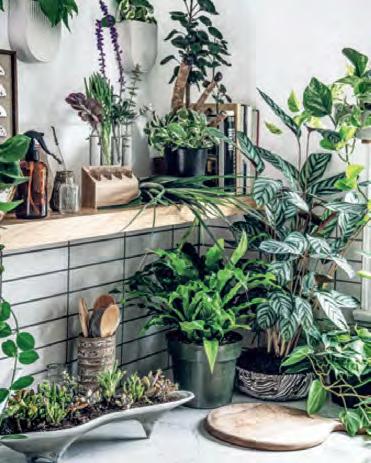
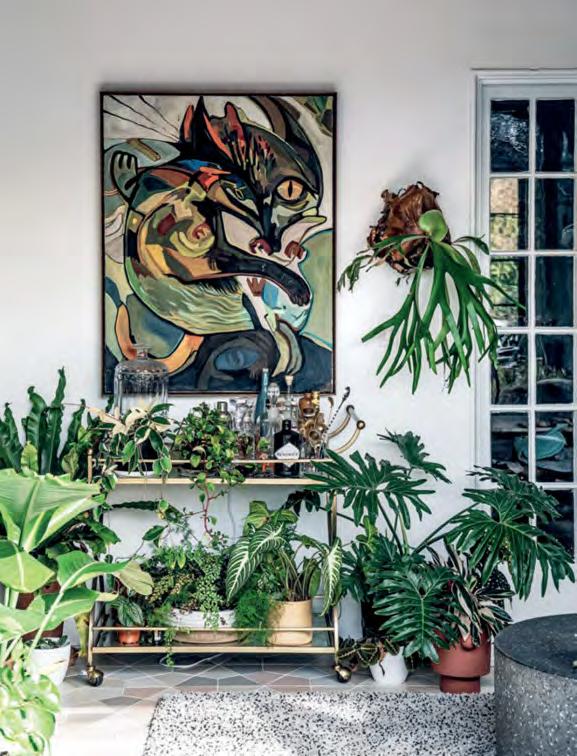
I loved the chapter, Styled Spaces – a Portfolio of Flora where we visit eight homes that have been plant styled by Hilton. It oozes inspiration.
This beautiful book is for anyone interested in interior design and loves plants (and maybe dreaming about them, too). It would make a great gift and be very at home on anyone’s coffee table in the middle of winter when our thoughts turn to houseplants.
Hilton Carter is considered an “influencer” with a huge following on Instagram (@hiltoncarter). He is a film director, editor and artist who is passionate about plants (his home is filled with 250 of them).
Living Wild How to Plant Style Your Home & Cultivate Happiness by Hilton Carter (CICO Books)

torontobotanicalgarden.ca 38 Fall 2023
each piece in this room was painstakingly picked to bring out the beauty in the piece next to it. opposite Bottom: The mix of colours in this painting by Jose Mertz helps to make the bar area feel lush.
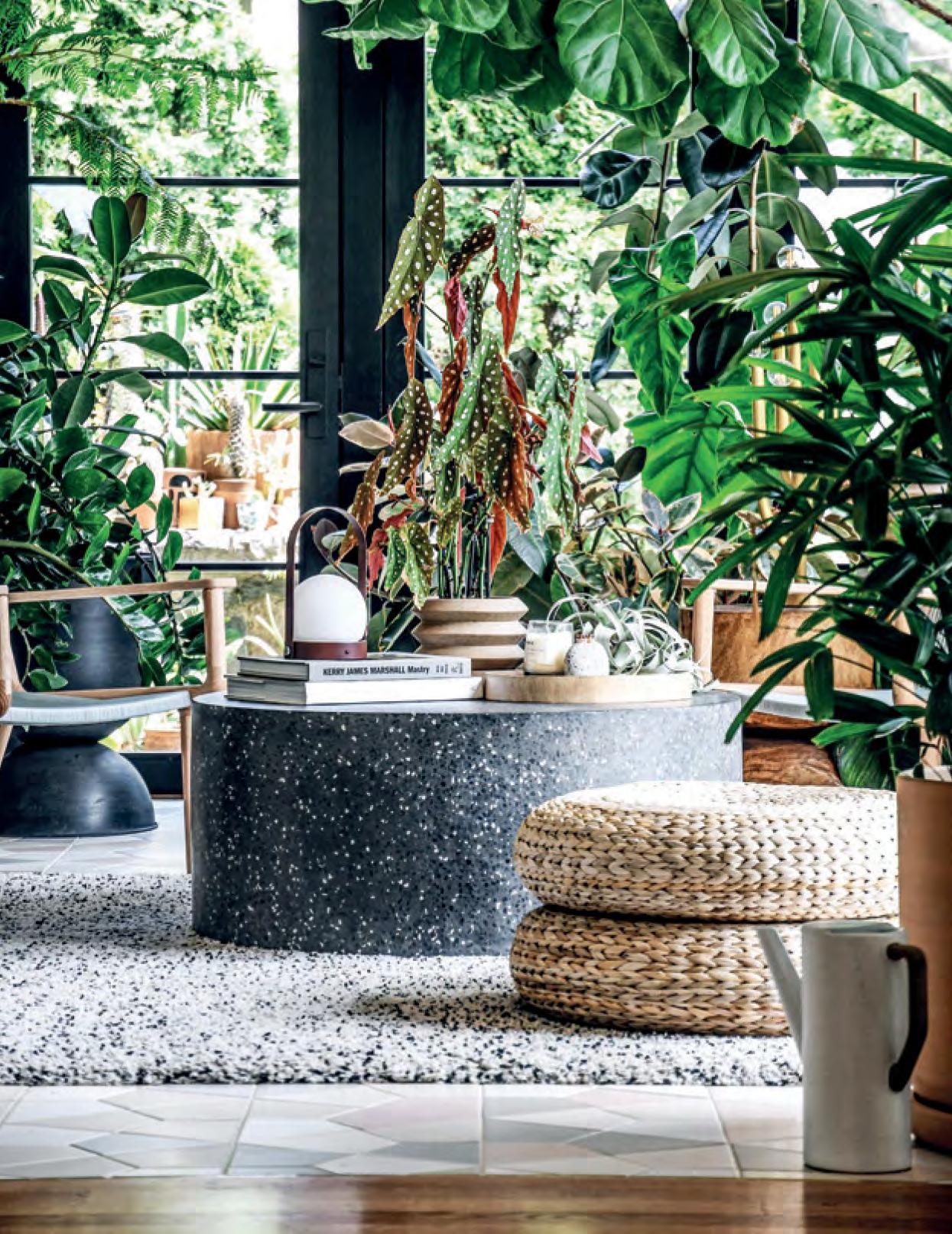
Ell E n finds Community and Pur P os E at th E t BG By Aleeshia Carman
Our community at the Toronto Botanical Garden is strengthened by the efforts of volunteers, each of whom fosters a unique connection with nature. Among them is Ellen Kessler, an example of how individual dedication can inspire the next generation of environmental learners and advocates.

When Ellen’s husband passed away, she was understandably a little lost, puzzled at what her next steps would be. Unsure of her future plans, Ellen soon found partnership with the Garden when her son encouraged her to volunteer. A fortuitous fit—the organization was in search of a vermicomposting expert and Ellen’s experience as a life-long environmental educator made her more than qualified.
“I volunteered in the Teaching Garden almost every day in May and June,” she says. “My goal is to make people’s day better.” Driven by a belief in the Garden and in environmental education, Ellen expresses that, “we owe it to the kids. We have a responsibility to help them navigate, learn, honour and respect nature.”
Drawing inspiration from the Iroquois Tribal Council’s principle that a decision today will impact the next seven generations, Ellen shares this lesson with her students in the TBG Teaching Garden. She believes that adults are responsible for nurturing a child’s innate gift of caring for human and non-human life.
Teaching children about vermicomposting tends to spark a squeamish “ew”. Ellen always laughs saying, “no, aw!” encouraging the children to reflect upon this creature’s importance in our ecosystems. After some time, the young minds increasingly become more engaged. Interest builds. Ears perk. Curiosity piques. Then, something spectacular happens.
“One little Grade Two student looks down and says, ‘it’s moving’. And, sure enough, there was a baby worm emerging
from the cocoon,” she says. What a fulfilling moment shared between a student and educator—together witnessing the first few breaths of this worm’s life.
For Ellen, life’s truest reward begins and ends with educating young people, among peaceful scapes of willows, spikey plants, vibrant flowers, birds and bees. Even at home, she embraces learning about native plants and caring for honeybees.
Ellen’s passion for fostering children’s connection with nature can be traced back to a schoolyard. Whenever children had difficulties in elementary school, Ellen would take out her shovel and introduce them to gardening at recess. “The moment you put a shovel in the ground, and pop in a seed, amazing creatures gather, and food comes to life,” she says. “As the children learn, I am learning alongside— there’s always more to explore.”
Ellen can’t imagine life without the Garden. She speaks warmly about her fellow volunteers, recounting that she once met a lady who commutes two hours by bus. “It’s a welcoming place and you know you’re contributing to the common good.” Gratitude fills her heart as she speaks about the need to protect places like the Toronto Botanical Garden and Edwards Garden. “We are an educational institution, important for teaching those small and large about environmental ethos, sustainability and the need to connect to our (and the) roots,” she says.
Ellen revels in how fortunate we are to be able to relax in the shade, to enjoy the sound of birds, to observe small creatures at work, and to relate to the natural world. “It totally changed my life,” she says. “From a person that didn’t know what to do each day, the Teaching Garden gave me purpose.”
torontobotanicalgarden.ca 40 Fall 2023
Volunteers
TBG Volunteer
Ellen Kessler up to her knees at the Teaching Garden.
All Good Things are Wild and Free

Reviewed by Lila Yorke
Th IS p U zzl E , featuring an exclusive illustration by Dutch artist Valesca van Waveren, is inspired by the words “All good things are wild and free,” written by henry David Thoreau in Walking. The picture replicates the simple joys of being in nature: a travelling snail, a fruiting tree, the hum of a grasshopper, sparkling constellations, the strong trunk of an oak.
After separating the outside edge pieces first, the inner ones seemed easier than most 1,000-piece puzzles to sort. Rocks, trees, animals, flowers and title letters are all in distinct colours and shapes
It was challenging enough to be enjoyable but not so difficult to be frustrating.
Pieces Puzzle
Hello Dahlias
Reviewed by Walter Sliva
ThIS 1,000 piece puzzle by Artisan puzzles, was created by Frances palmer, a gardener who is obsessed with dahlias, growing them by the hundreds in her Connecticut garden.

The picture is a gorgeous array of blooms, in colours from white to golden to pink to scarlet, all exquisitely laid out on a slate floor.
Once you’ve laid out the straightedged border, don’t imagine you’re nearing the end of the project. I was shocked at how many shades of gold and orange and pink there were, and how long it took to find which corner of the puzzle each piece belonged to.
Not for the impatient puzzler looking for quick gratification, but a true work of art once completed!
torontobotanicalgarden.ca 41 Fall 2023
Ah, the internet—an endless stream of tips and tricks, and, well, a whole lot of nonsense. With 78 per cent of gardening advice made up, the information you find lurking in the corners of the world wide web can really put a damper on your planting journey. But fear not! We have enlisted the help of Toronto Botanical Garden’s own Director of Horticulture, Roger Gettig. Let’s dig into the truth of the matter and debunk some of the internet’s worst botanical claims.
Beware
1 Cinnamon Craze A sprinkle of cinnamon: an irresistible addition for a baked good or on top of a latte. When a group of scientists published Extraction and Potential of Cinnamon Essential Oil Towards Repellency and Insecticidal Activity, some plant enthusiasts ran with the simple conclusion that sprinkling cinnamon on a plant can both prevent ants from eating its leaves and mould from growing. They neglected to mention that the study found only high concentrations of extracted chemical compounds from cinnamon may repel ants. Roger’s take? Put the store-bought cinnamon back in the kitchen where it belongs.
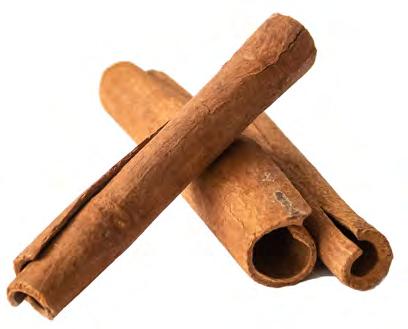
Ants are not after your plants. They are often seeking shelter, or their presence indicates that aphids have found their home and are creating honeydew, a sugary liquid waste on which ants love to snack. Roger concedes that repelling ants isn’t the solution. Getting rid of aphids is. Try submerging your potted plant just above the soil surface in two tablespoons of insecticidal soap and one quart of water for 20 minutes, before draining thoroughly, suggests Roger.
10 Wacky internet gardening Myths debunked
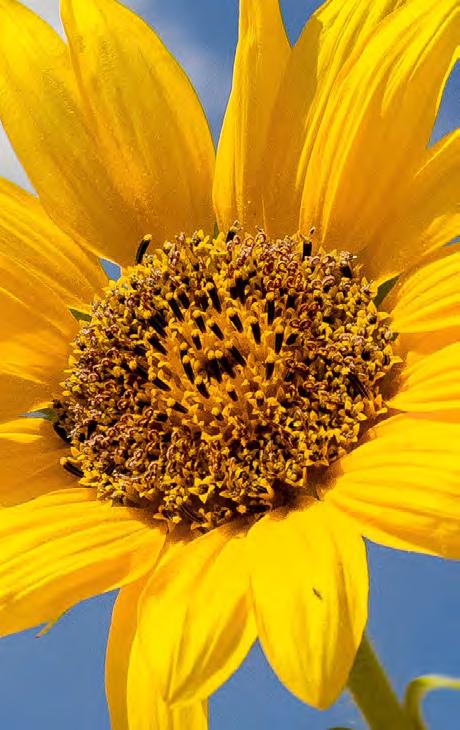 By Aleeshia Carman TBG Grant Writer and Development Coordinator
By Aleeshia Carman TBG Grant Writer and Development Coordinator
2 Sunflower Oil One TikTok user suggests soaking a scarf in sunflower oil and wrapping it around a tree to stop creepy critters from setting up camp. But hold on there! While certain oils, designed to control insects and sprayed directly on them may prevent bugs at a certain point in their lifecycle, says Roger, it isn’t a surefire method. Also, this trick does nothing for the flying creepy crawlies. And, if it’s ants you’re worried about, part of the tree may be dead or decaying. In this case, it’s best to assess for damage.
3 Vinegar Vinegar can clean your bathrooms and kitchen, so it is only logical that it will leave your plants lookin’ and feelin’ squeaky clean, too, right? While this TikToker’s assumption may seem correct on its face, there could be deadly consequences. Vinegar may have the power to kill weeds, but it does not discriminate and will take down your healthy plants, too, says Roger. Acetic acid will do more harm than good, dissolving the plant’s cell membranes.
4 Snake Plants Snake plants help to purify the air in homes, which is

torontobotanicalgarden.ca 42 Fall 2023
why they are a staple of most offices. Some internet users claim that making a new one is simple: snip off a leaf, cut a V-shape at the base, and stick it in water. Boom! Roots will emerge in weeks. Here’s the thing. Roger argues that the V-shape notch can be helpful but isn’t necessary. Rather, “let the leaf sit for a day or two so the bottom calluses before rooting,” he says. “Then, put the leaf in a moist potting mix.”
5 Repotting Many users are spewing the misconception that you shouldn’t repot a new plant for a month, as it needs time to acclimate to its new environment. But Roger disagrees. “Repot a plant when the roots fill the pot but before the plant becomes root bound,” he says. “If it doesn’t need to be repotted, leave it be.”
6 Watering Woes Are your plants getting enough water? This TikToker argues that they aren’t. To rectify the situation, she recommends bottom watering, the ultimate hack for equal distribution of hydration to the roots. On the contrary, Roger says it really doesn’t matter—plants will eventually soak up excess water anyway. Also, watering from the bottom means that the mineral buildup will leave an unsightly ring—this doesn’t hurt the plant, but some people avoid this look.
7 Scissor Skills
it off and shape the leaf with scissors to perfection, one plant enthusiast recommends in a demonstration. Because, as you may or may not know, plants reseal themselves. Err… Not exactly. While you can cut off a dead tip, cutting off any healthy tissue may cause more damage, says Roger. Since there is less surface area for photosynthesis to occur, the plant can’t make as much food, reducing its ability to recover and photosynthesize.
baffled and responded with one simple answer: “No.” But what’s the worst that could happen? “The worst outcome is that you waste a perfectly good cup of coffee,” he says. More broadly, Roger says that it all comes down to what the plant needs— balanced soil, light and water. Everything else is totally unnecessary and doing more harm than good.
10 Water Wisely Should you rely on leaf-curling to tell you when a plant needs a drink? Not necessarily, says Roger. “Stick your finger into the soil and see if the first inch is dry. If so, it’s time to water.” If you’re waiting for the leaves to dry out, then you could be stressing the plant, resulting in it looking ratty.

8 Banana Bonanza We have a banana frenzy on our hands. Some suggest rubbing bananas on your face and other internet users recommend soaking a banana peel in water for plant fertilizer. A little extra potassium never hurts anyone (or a plant), did it? Roger has one question to ask these banana-loving plant enthusiasts: Does your plant even need potassium to begin with? While plants do need potassium, phosphate, and nitrogen, there is a delicate balance to follow. This is why Roger says it would be better to use a balanced fertilizer for houseplants, rather than guessing.

On that note, anyone who tells you to water your plants on schedule is sadly mistaken. Many social media personalities encourage having plants because they are easy and can be watered according to a schedule. This is untrue. In fact, you may risk over or underwatering your plants, says Roger. Each plant deserves its own care plant plan. That is, check each plant’s pot size, pot material, placement, soil, and watering. Using a moisture meter will help you determine whether a plant needs watering. Plus, plants don’t need as much water in winter, when they slow down, as compared to the springtime when they are actively growing, says Roger.
So, there you have it: Roger’s take on the wild world of internet gardening advice. Trust your instincts and when in doubt, consult with the experts at Toronto Botanical Garden or Toronto Master Gardeners!
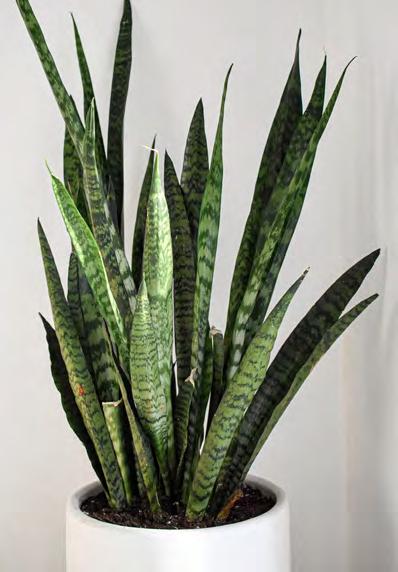
torontobotanicalgarden.ca 43 Fall 2023
All-night festival at the Garden September 23
Nuit Blanche comes to the tbg for the first time from 7 p.m. Saturday, September 23 to 7 a.m. the next morning. the garden will host two interpretive artists - radha chaddah and grace grothaus - onsite, each with different interactive installations that illuminate plants and trees.
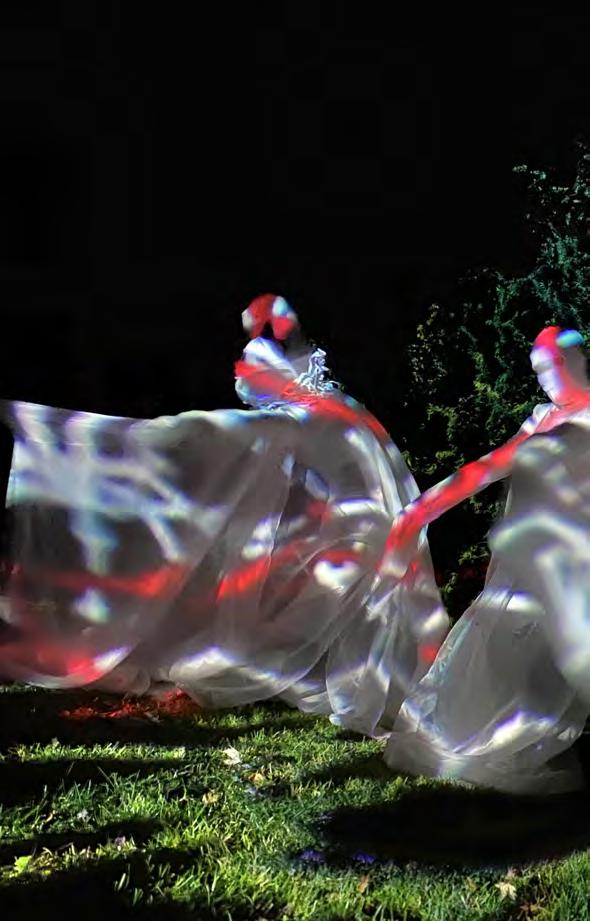
nuit blanche is an annual all-night festival held in cities around the world to celebrate contemporary arts. this year’s toronto theme, breaking ground, invites artists to explore ideas centred around the natural world. For one dazzling night neighbourhoods around the city will embrace inspiring popup art installations.
Radha Chaddah makes art about invisible realities using light as her primary medium. Her work examines the interconnectedness of our material reality from the micro to the macro. in her studio, she designs large-scale projected light installations for public exhibition. She prepares samples and shoots much of this imagery in laboratories at the University of toronto. Her photographs and light installations have been exhibited across canada.
iaM (ee-yam), latin for ‘now,’ is about human enmeshment within nature, and the perspective we gain when we consider parallel, non-human narratives. it follows the story of the pandemic through four distinct material realms—Molecular, Human, earthly and cosmic.

iaM is a performance installation with a stage made entirely of projected imagery cast onto trees and grass. audience members are seated or can stand on grass at the edge of the stage, as the dancers play amidst vividly coloured, animated 3d imagery. the immersive visuals take the viewer into a vastly magnified microscopic realm, as the projected imagery was produced and photographed in laboratories at the University of toronto. this represents a symbolic re-framing of our relationship to the natural world, reminding us that we are only a small part of the evolutionary narrative of life on earth.
Following the live performance, the audience is invited to experience the stage as a light sculpture installation. as they explore the space, they will discover a change of perspective in the projected scenography, while their bodies are covered with the intricate light patterns of molecules, bodily tissues and energies.

torontobotanicalgarden.ca 44 Fall 2023
Good Things are happening
ACT
ACT 1 - Dance of the Molecules
2 - Of Body and Mind
GRaCe GRoThaus is a computational media artist grappling with the climate crisis. Her practice-based artistic research encompasses environmental sensing, physical computing, machine learning and speculative futurity.


grace’s installation Sun eaters uses custom electronics to visualize bioelectricity as light. a grove of trees at the tbg will be equipped with branches the artist has created to enable people to both see and feel a tree’s “heartbeat”. at several touch stations, visitors can hold the branches she made, which contain sensors that pick up the bioelectric rhythms of each tree.
the installation shows the electrical patterns unique to each tree, a constantly shifting combination of internal factors including the tree’s overall health, daily metabolic processes and state of hydration. their pulsing rhythms are also influenced by external environmental cues such as time of day, season and the lunar cycle. grothaus is interested in creating artworks that facilitate points of connection between humans and the more-than-human natural world.
“i am investigating whether artworks can act as an interface for understanding ecological processes,” she says, hoping that the installation will prompt a deeper appreciation of trees and a means of seeing them as unique individuals, similar to how we see each other.
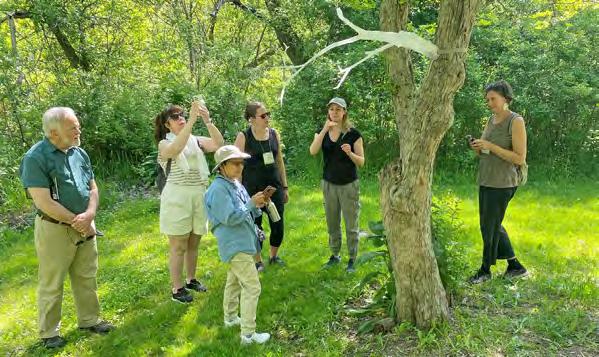
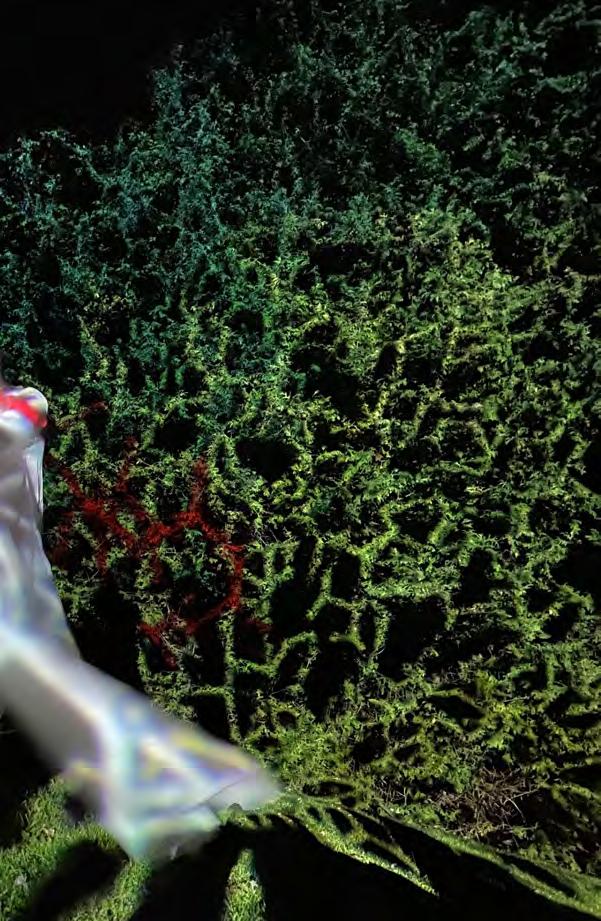
torontobotanicalgarden.ca 45 Fall 2023
ACT 3 - Earthly (Lotus)
Artist Grace Grothaus shows people how trees flow with hidden energy. She designed branches that reveal bioelectric currents inside them for her installation Sun Eaters.
Edwards Summer Music Series


thursday evenings through the summer were hopping at the tbg as the Farmers Market continued from 3 to 7 p.m., the garden Shop stayed open until 7 p.m., there was a free drop-in centre for Family activities from 4 to 7 p.m. and the edwards Summer Music Series drew happy crowds for eight weekly shows throughout July and august. broadcaster anwar Knight hosted the concerts which ranged from jazz to blues, Scottish-reggae to classical.
tAFElMuSik BAroquE
orcHEStrA three-part winter series was such a success that another concert is scheduled for Sunday, Nov. 12 at 2 p.m. with additional ones planned for 2024. Watch for more information. •

tHE AMAdEuS cHoir also did so well with their rendition of Nipiy’s Songwalks last spring, that they, too, will be returning to the TBG in the near future.

Food, driNkS, HANdicrAFtS ANd MorE.
Save the dates for the TBG’s Holiday Market, taking place over two weekends this year: Friday, November 24 to Sunday, November 26 and Friday, December 15 to Sunday, December 17.
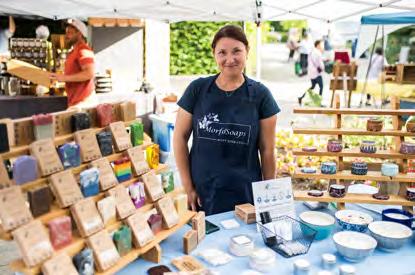 Indigenous singer Mimi o’Bonsawin
Crowds of music lovers enjoyed the edwards summer Music series every Thursday.
Top: Farmers Market
Top Right: VC2 Classical cellists
Indigenous singer Mimi o’Bonsawin
Crowds of music lovers enjoyed the edwards summer Music series every Thursday.
Top: Farmers Market
Top Right: VC2 Classical cellists
Bloom:dance+circus in the Garden, developed in partnership with artists’ Play dance + circus Studio, performed afternoons and evenings July 10 through 19 was a huge success. this immersive, outdoor, high-flying dance, circus and garden experience led the audience through the garden to secret performance locations as they discovered cheeky gnomes, nimble fairies and silly frogs swinging through the sky and above the hedges.
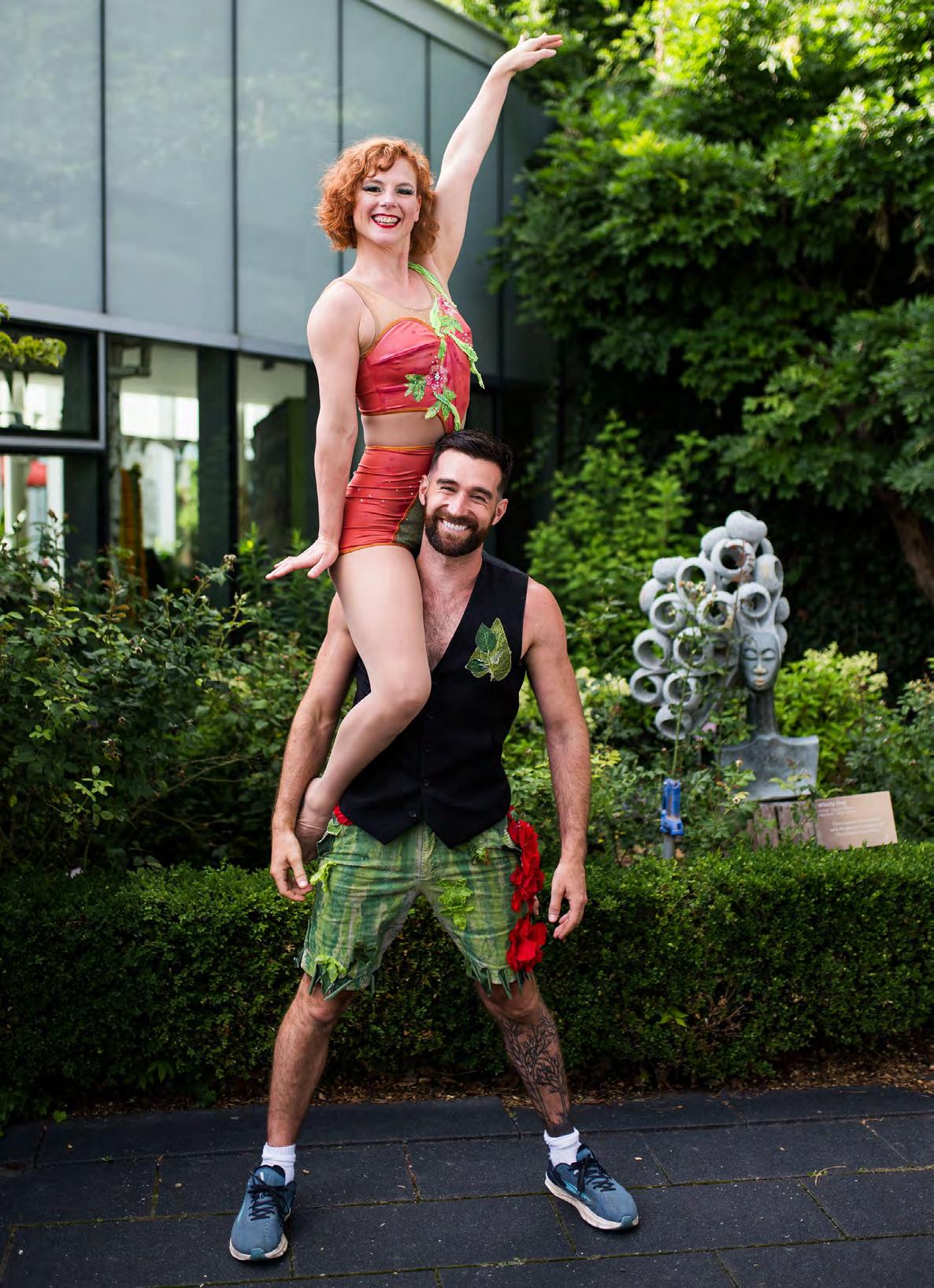 elizabeth snell and Woody Fox kept audiences entertained throughout the show.
elizabeth snell and Woody Fox kept audiences entertained throughout the show.
t hrough the Garden Gate, r iverdale, in early June was blessed with good weather and well supported by staff, volunteers and garden tourists. the gardens were beautiful and the homeowners welcoming. attendees were
25 per cent tbg members and 75 per cent public.
in a visitor feedback survey, more than 95 per cent of respondents rated their overall experience between good and excellent. noted highlights included the variety of gardens,






meeting the homeowners, having their questions answered by toronto Master gardeners, walkability of the area supplemented by shuttle buses and the fun, friendly and community feeling of the event. next year’s tour will be held in Swansea.
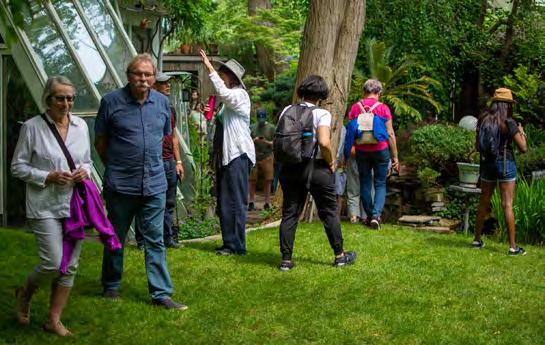
More than 95 per cent of respondents rated their overall experience between good and excellent.
Garden obelisks Make use of vertical space in your garden with a 4 or 6-foot obelisk. Made in toronto exclusively for the toronto botanical garden, these obelisks are superb structures for showcasing and supporting vines and vegetables. black, powder-coated steel ensures that these towers remain rust-resistant and durable for many years to come. available throughout the year at the Garden shop. available in two sizes: 4 ft $99.99; 6 ft $124.99.

Sales Representative, ABR, SRES H AL L O F FAME AWAR D LI FE TI ME ACHI E VEMEN T AWAR D TOR ON TO M ASTER GA RD ENE R RE/MAX HALLMARK REALTY LTD., BROKERAGE Direct 416.564.9450
@JoseeCoutureTorontoRealEstate
• classified •
Plant Profile
Dark D ramatic foliage takes centre stage this fall
By Georgie Kennedy
GardeninG influencers have begun to feature showy plants as elements of décor, both indoors and out. Gone are the dried flower arrangements of the 1980s and the artificial silk office plants of the 2000s. No more plain petunias in a window box or boring geraniums all in a row. Only the stylish, the outrageously gorgeous and the exotic will do to give oomph to an entrance hall or backyard patio. Non-traditional is the order of the day.
I am riveted by ebony coloured foliage in containers and in garden beds, whether as the focus shrub in a foundation planting or trailing down the front of a pot, and they provide a remarkably brilliant contrast when paired with chartreuse or silvery plants.
The following is a list of my favourites, with no instructions or cautionary tales. Most plants come with care labels, and YouTube has millions of videos. I’ll leave it to you to decide whether you can provide the right attention for a new darling and to figure out when to bring it indoors for storage or display. Be prepared to fall in love with any of the following dramatic dark plants this fall:
Tropical:
• Zamioculcas zamiifolia Raven™ (Raven ZZ Plant)

• Colocasia esculenta ‘Black Magic’ (Taro or Elephant Ears)
• Ipomoea batatas ‘Sweet Caroline Sweetheart’ JET BLACK ™ (Sweet Potato Vine)
• Ipomoea batatas ‘Solar Tower’ ™ Sweet Potato Climbing Vine)
• Philodendron McColley’s Finale
perennial:
• Astilbe ‘Dark Side of the Moon’ (False Goatbeard or False Spirea)
• Ligularia ‘King Kong’ (Leopard Plant)
• Heuchera ‘Obsidian’ (Coral Bells)
• Heuchera ‘Black Beauty’ (Coral Bells)
• Heuchera ‘Black Pearl’ (Coral Bells)

• Ophiopogon planiscapus ‘Nigrescens (Black Mondo Grass)
shrub:
• Sambucus ‘Black Beauty’ (Elderberry) with its airy pink flowers
herb:
• Ocimum basilicum var. purpureum ‘Dark Opal’ (Black Basil)
Beware of Invasives
Some Ontario nurseries are still retailing plants on the invasive plant list (https://www.ontarioinvasiveplants.ca/ invasive-plants/species/). Please consult this list before accepting a gift or making a purchase that you intend to plant in a permanent spot. Here is a simple guide to healthier alternatives: https://www.ontarioinvasiveplants.ca/wp-content/ uploads/2020/04/Southern-Grow-Me-Instead-1.pdf We all benefit from a stronger eco-system.
torontobotanicalgarden.ca 49 Fall 2023 P H oto S : g eorgie Kennedy
Raven ZZ Plant
heuchera ‘obsidian’
NAture WeAviNG
Make a piece of art to capture the memory of summer
By Gino Amboang and Lindsay Chisholm TBG Nature Educators
Nature weaviNg is a fun craft and mindful activity for all ages. It’s a great way to make a piece of art or remember a special hike, using string, sticks, flowers and other things collected on a walk. It’s a good way to encourage tactile senses and help develop fine motor skills.
What you’ll need
you can hang your dried weaving board on a wall as an art piece, a visual memory board or wall potpourri if you use flowers that have a scent once dried such as lavender.
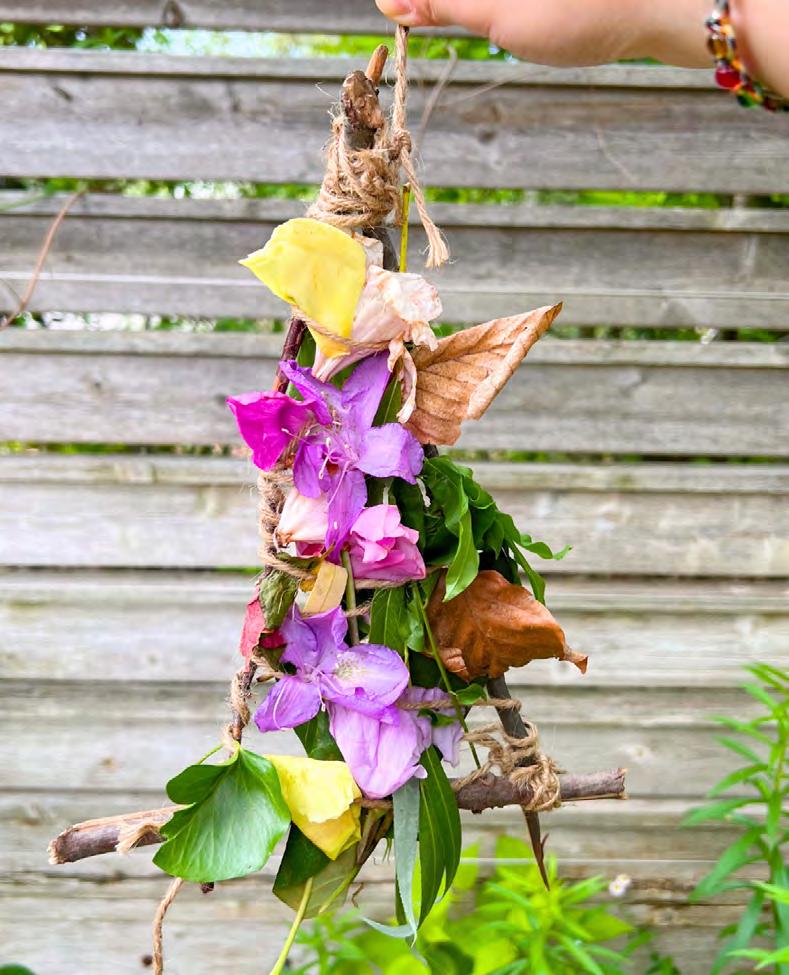
How to make them
• Collect sticks to make your weaving frame.
• Place the sticks on a table in the shape you’d like your frame to be. Try making a square or rectangle!
• Tie the sticks together by wrapping a string at each of the connecting ends. Secure each with a tight knot. Try using different kinds of wilderness knots.

• Now let’s create the grid for your found materials. Wrap a long string back and forth, vertically across the frame and then again, horizontally. Make sure the string feels tight.
• Take your weaving board with you on your next nature walk! Or collect things to weave once you return home.
torontobotanicalgarden.ca 50 Fall 2023
Diy
BOAR d OF di RECTORS
Gordon Ashworth, b oard Chair
Barb Anie, Dianne Azzarello, Adeline Cheng, Doris Chee, Michele Chandler, Ben Cullen, Tony DiGiovanni, Lisa Ellis, Susan Grundy, Abdullah Hamidi, Margareth Lobo Gault, Helder Marcos, Haig Seferian, Martin Ship, Janice Winton
e x o fficios: Michael Erdman (Milne House Garden Club), Derryn Gill (Garden Club of Toronto), Christina Iacovino (City of Toronto)
Your support and engagement are essential in developing an inspired plant place, an engaging learning environment, and a dynamic community hub. We invite you to grow with us.
mission
Toronto Botanical Garden connects people and plants, fostering sustainable communities and developing reciprocal relationships with nature through lifelong learning.
V ision
Toronto Botanical Garden is a garden for all; a diverse community that recognizes the life-giving role of nature, working together for a more sustainable world.
si G n U p F or G arden ene W s !
Receive the latest horticultural news and information on events, workshops, lectures and other horticultural happenings. Free registration at https://torontobotanicalgarden.ca
Visitor Centre: Open daily, 9 a.m. to 4:30 p.m.
Garden shop: Open daily, 10:30 a.m. to 4:30 p.m.
Weston Family library: Weekdays, 10:30 a.m. to 4:30 p.m.
Weekends, 12 to 4 p.m.
tbG bloom CaFe: (located in the historic barn)
Weekdays, 9 a.m. to 5 p.m.
Weekends, 9 a.m. to 7 p.m.
The café will close for the season in late Fall.
parkinG: $2.50 per hour. Members and TBG Volunteers, FREE
ExECuTIvE DIRECTOR
Stephanie Jutila sjutila@torontobotanicalgarden.ca
EDuCATIOn 416-397-1355 education@torontobotanicalgarden.ca
DEvELOpmEnT 416-397-1372 development@torontobotanicalgarden.ca
FACiLiTy REnTALS 416 397-1324 events@torontobotanicalgarden.ca
GARdEn ShOP 416-397-1357 retail@torontobotanicalgarden.ca
GARdEninG hELP LinE Toronto Master Gardeners 416-397-1345 torontomastergardeners.ca
GROuP TOuRS 416-397-4145 tourguides@torontobotanicalgarden.ca
hORTiCuLTuRE 416-397-1358 horticulture@torontobotanicalgarden.ca
MARkETinG & COMMuniCATiOnS
416-397-1351 communication@torontobotanicalgarden.ca
MEMBERShiP 416-397-1483 membership@torontobotanicalgarden.ca
TRELLiS MAGAzinE editor@torontobotanicalgarden.ca
VOLunTEER SERViCES 416-397-4145 tourguides@torontobotanicalgarden.ca
WESTOn FAMiLy LiBRARy 416-397-1343 librarydesk@torontobotanicalgarden.ca
eDitor
lorraine HUnter
DesiGN
JUne anderson
treLLis Committee
leanne bUrkHolder
sUe Hills
georgie kennedY
JennY rHodeniZer
lee robbins
Veronica sliVa
voLuNteer
ProofreADers
Jackie caMPbell
lYn HickeY
Jean McclUskeY
Marg anne Morrison
rose roberts
ADvertisiNG
416-397-4145
Trellis is published as a members’ newsletter by the toronto botanical garden at edwards gardens
777 lawrence avenue east, toronto, ontario, M3c 1P2, 416-397-1341
Trellis welcomes queries for story ideas, which should be submitted to the editor for consideration by the trellis committee at least four months in advance of publication dates.




opinions expressed in Trellis do not necessarily reflect those of the tbg submissions may be edited for style and clarity.
©2023 all rights reserved. reproduction in whole or in part is prohibited without the written permission of the toronto botanical garden.
Charitable registration number 119227486rr0001





777 Lawrence Avenue East, Toronto Ontario M3C 1P2, Canada • 416-397-1341 fax: 416-397-1354 • info@torontobotanicalgarden.ca torontobotanicalgarden.ca • @TBG_Canada

By TTC: From Eglinton subway station take the 51, 54, 54A or from Lawrence subway station take 162 bus to Lawrence Avenue East and Leslie Street. The TBG is on the southwest corner.

Find us on...

DIRECTORY M AST h EA d
TORO n TO BOTA ni CAL GAR d E n i S A GAR d E n FOR ALL REG u LAR h O u RS OF OPERAT i O n
FARMERS MARKET AT THE GARDEN
Thursdays from 3 to 7 p.m.
May 11 through October 5
Freshest local produce, artisanal products, and unique food items from farmers and small businesses in the GTA and includes FREE drop-in family activities (4 to 7 p.m.), and a FREE gardening advice clinic provided by the Toronto Master Gardeners. in partnership with Appletree Markets
NUIT BLANCHE AT THE GARDEN
For one dazzling night neighbourhoods around the city will embrace inspiring popup art installations. For the first time, the Garden will host two artist installations, IAM by Radha Chaddah and SUN EATERS by Grace Grothaus.
Saturday, September 23, 7 p.m. to 7 a.m.
FREE Admission
IAM AT THE GARDEN
Performance Installation & Artist Talk
A site-specific performance installation on an immersive light stage projected onto trees and grass by artist Radha Chaddah.
Wednesday, September 27, 7 to 11 p.m. Pre-registration required. Limited capacity.
WHAT'S ON 2023
GUIDED GARDEN TOURS

May through October, weekly tours of the Garden and Wilket Creek Ravine. Dates and times vary.
Adults $20, Student/Senior $10 Children Free. Pre-registration is required.
TORONTO'S RAVINE DAYS
An annual city-wide celebration of Toronto's ravine system including talks, tours, markets, and creative workshops held in collaboration with community partners. September 30 through October 9
TAFELMUSIK AT THE GARDEN
Sunday afternoon concert series with Tafelmusik, one of the world’s leading period-instrument ensembles. Indoors. Sunday, November 12, 2 p.m.
Tickets $25 (Members $23)
HOLIDAY MARKET
Eco-minded, nature-inspired, relaxed shopping experience with over 100 local vendors, workshops, live music, and more.

First weekend: November 24 to 26
Second weekend: December 15 to 17
FREE Admission
in partnership with For the Love of Markets
FOR A FULL LIST OF UPCOMING PROGRAMS AND EVENTS VISIT
torontobotanicalgarden.ca/event
TorontoBotanicalGarden @TBG_Canada #TorontoBotanicalGarden
photo credit: IAM/Radah Chaddah































 By Lee Robbins
By Lee Robbins











 Photos: Ball h orticultural
Coleus Solar Flare
Photos: Ball h orticultural
Coleus Solar Flare
 By Leanne Burkholder
By Leanne Burkholder


 By Veronica Sliva
By Veronica Sliva























 Veggie and herb labels
Selection of secateurs
Bag of gloves
Cleaning rags
Holes drilled and marked for each size of screwdriver.
Yellow dust catcher tucked between a shovel and a spade
Veggie and herb labels
Selection of secateurs
Bag of gloves
Cleaning rags
Holes drilled and marked for each size of screwdriver.
Yellow dust catcher tucked between a shovel and a spade




 New England aster with tattoos (leaf minor damage)
New England aster with tattoos (leaf minor damage)
 By Carol Gardner
By Carol Gardner
















 By Aleeshia Carman TBG Grant Writer and Development Coordinator
By Aleeshia Carman TBG Grant Writer and Development Coordinator















 Indigenous singer Mimi o’Bonsawin
Crowds of music lovers enjoyed the edwards summer Music series every Thursday.
Top: Farmers Market
Top Right: VC2 Classical cellists
Indigenous singer Mimi o’Bonsawin
Crowds of music lovers enjoyed the edwards summer Music series every Thursday.
Top: Farmers Market
Top Right: VC2 Classical cellists
 elizabeth snell and Woody Fox kept audiences entertained throughout the show.
elizabeth snell and Woody Fox kept audiences entertained throughout the show.


















